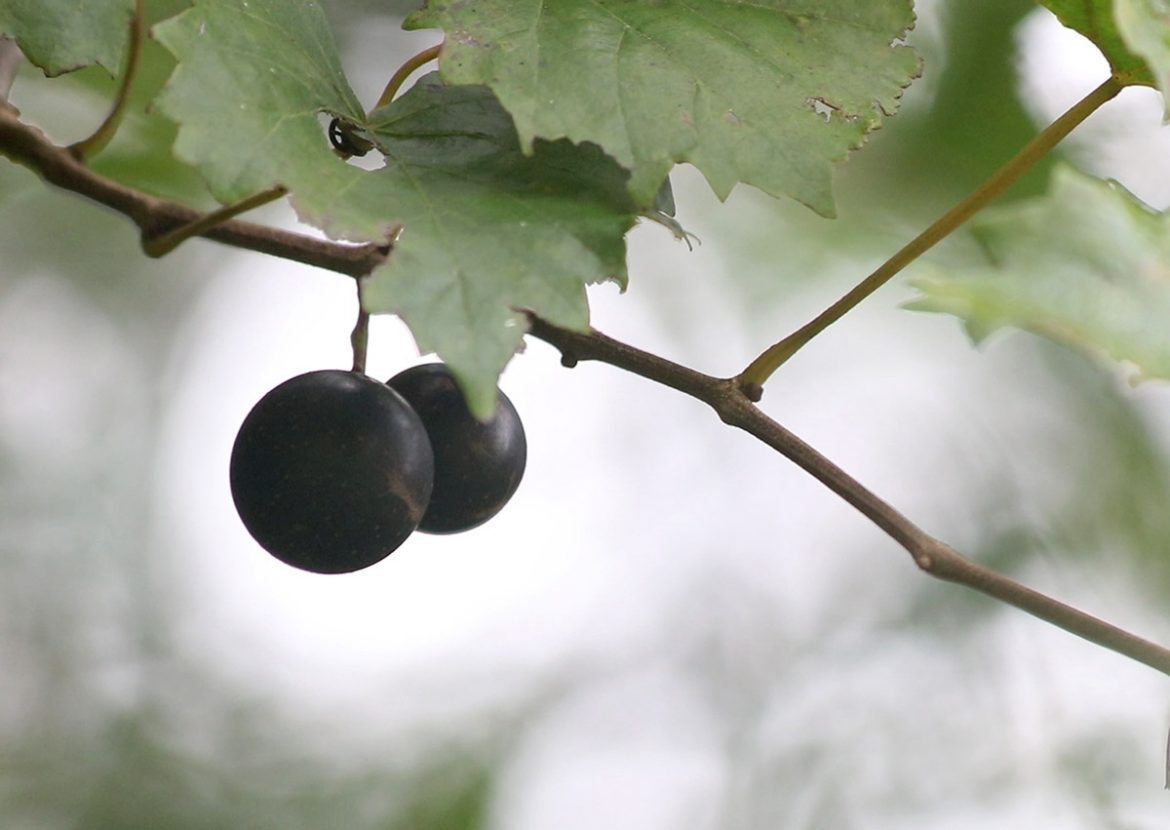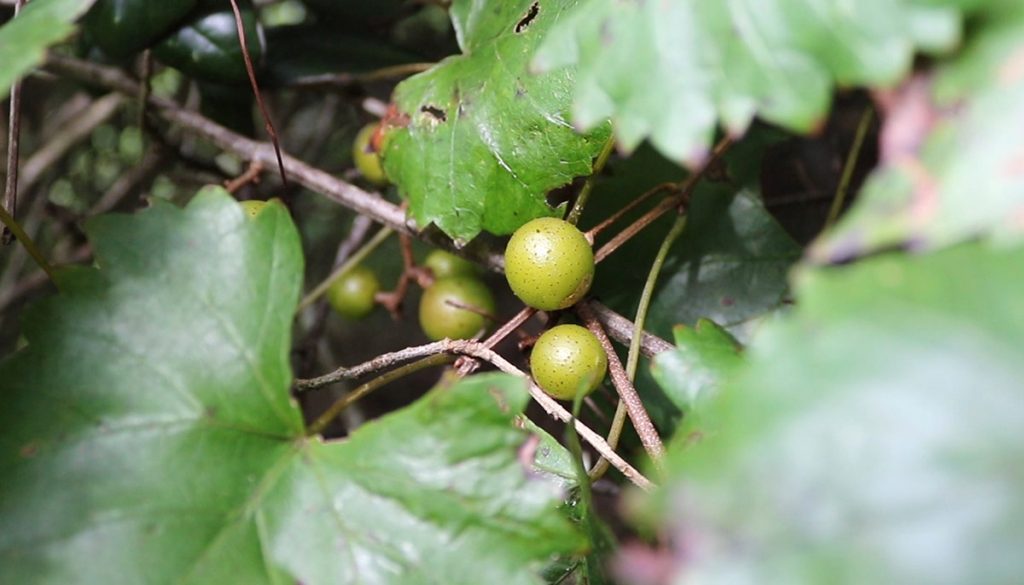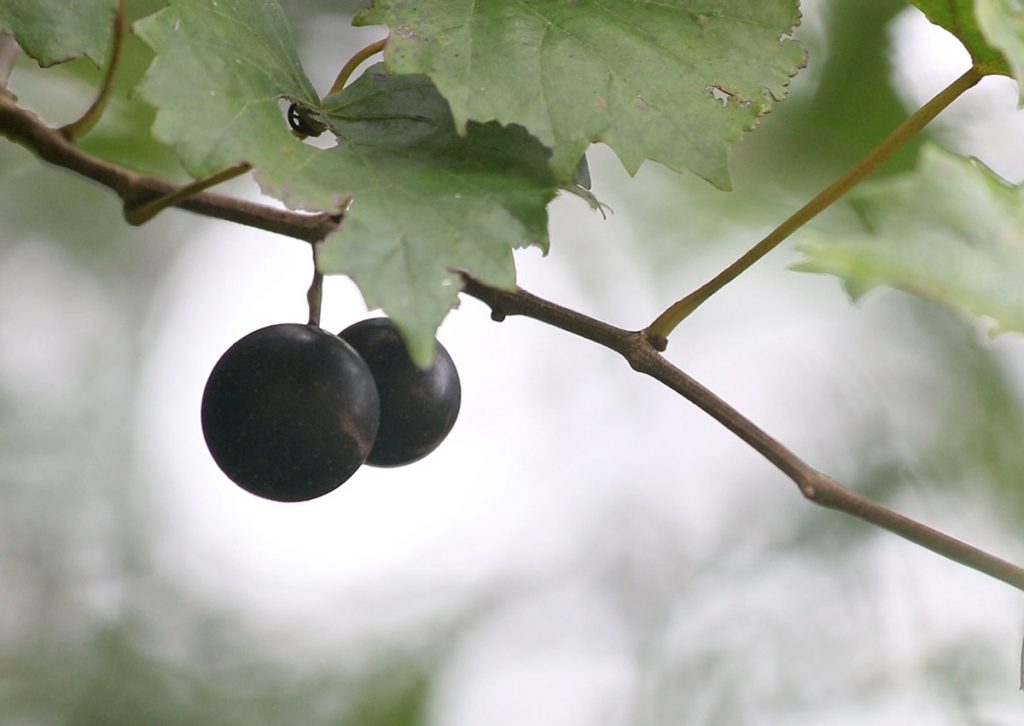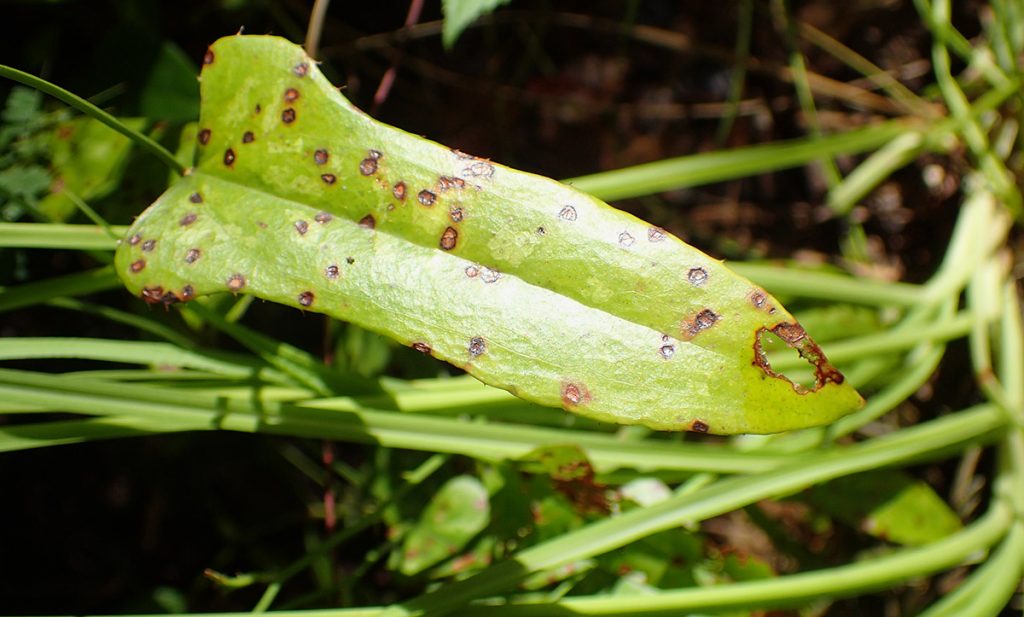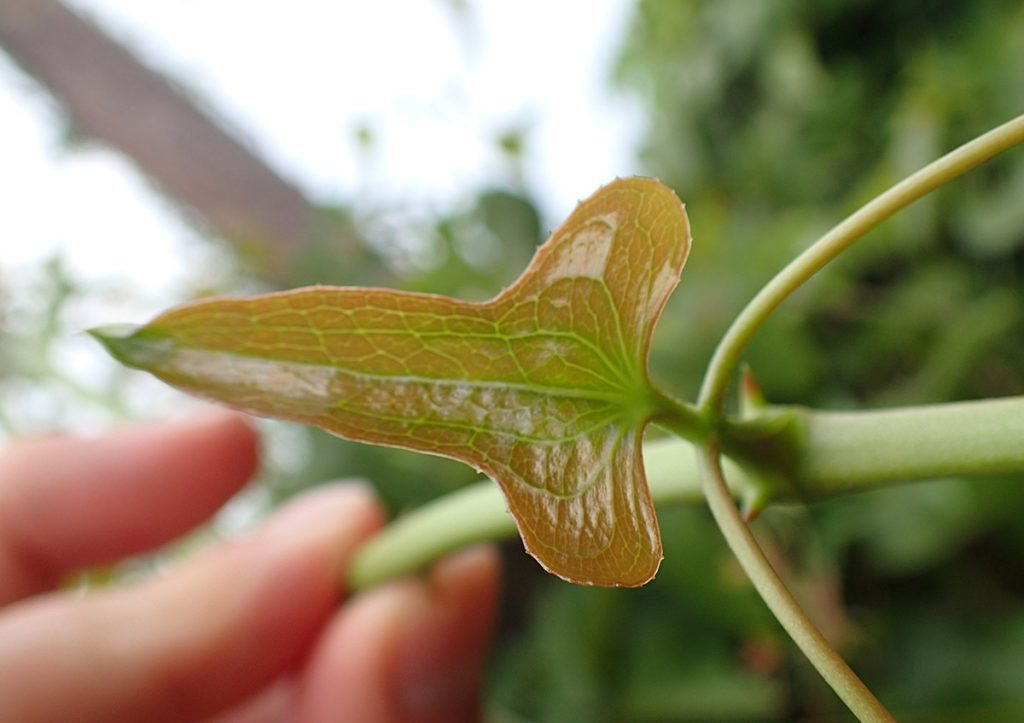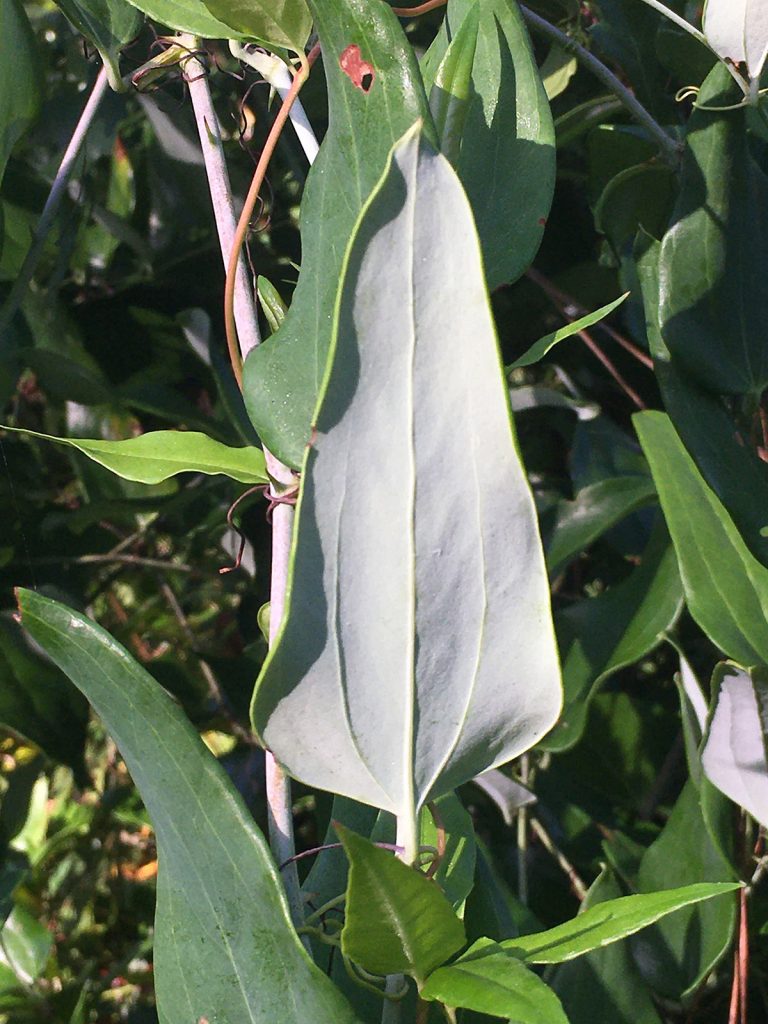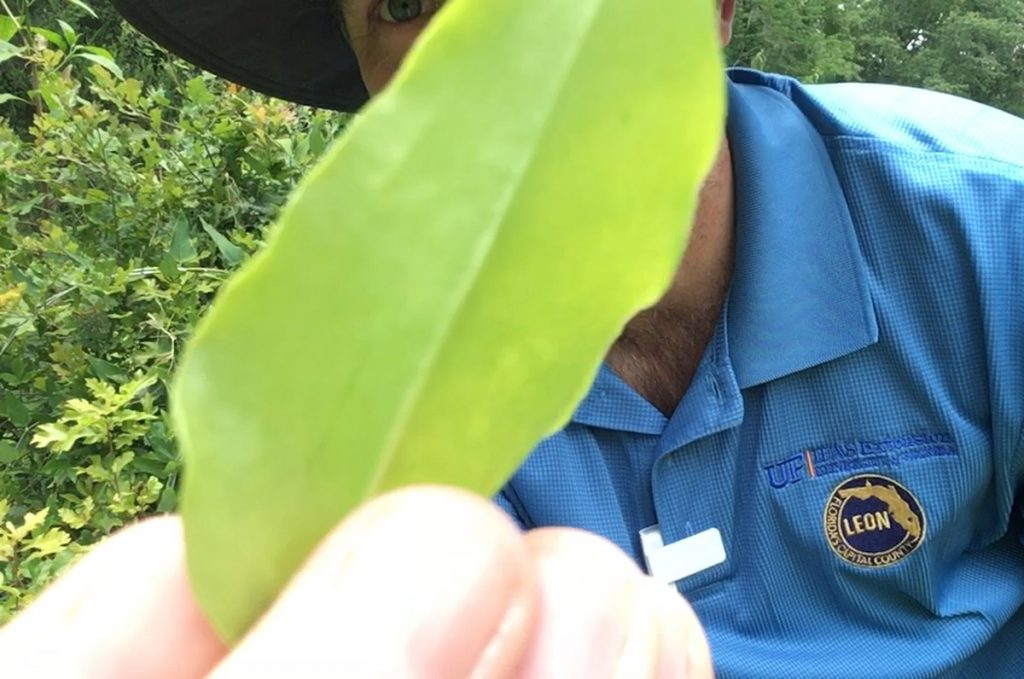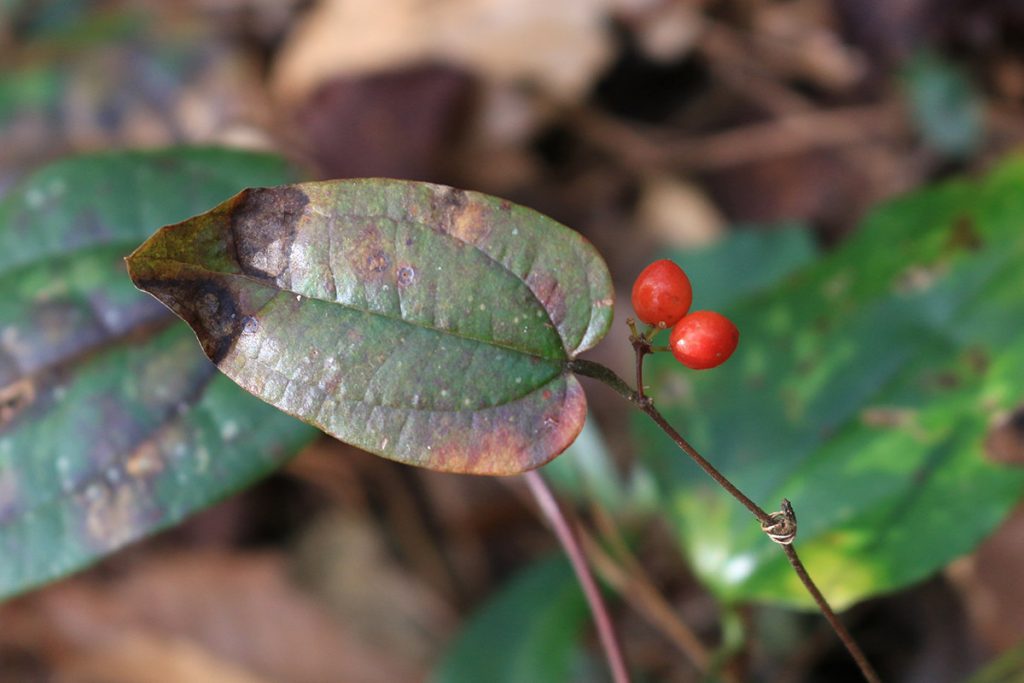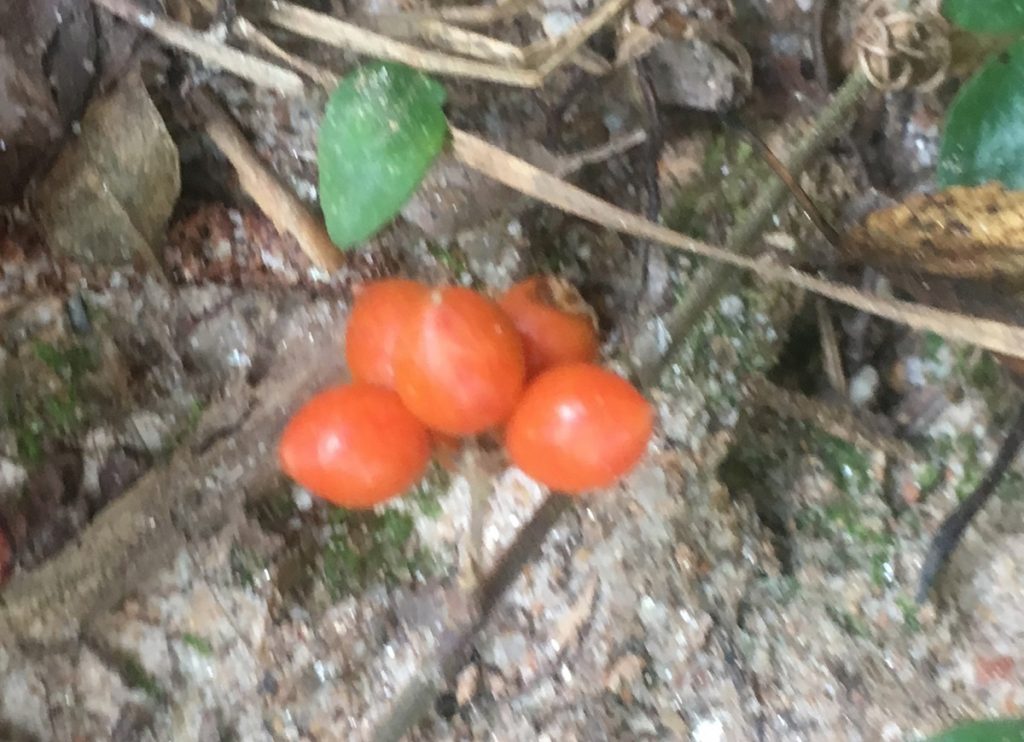To a lot of homeowners, vines are a real pain. If you cut them down, they grow back again. And if you go to dig up their roots, you could be in for a good bit of work. They’ll grow where it’s least convenient, and cover our other plants, fences, and even the walls of our homes.
But, like any of the weeds that grow in our yards, they can add value to our home ecosystems. Maybe, just maybe, there’s a reason to let a vine grow.
When a plant sprouts up without our having put it there, it’s helpful to ask a few questions before going ahead and pulling it. One is, what is this plant? We want to know if it’s native of invasive, and whether it has any qualities we appreciate – for instance, it might be a larval food plant for a particular butterfly species.
Also, where is this plant growing? Maybe you have a spot you let get a little wild, for the ecological benefits. Or maybe a vine is crawling up onto your deck, where you don’t want it. And some weeds get shrubby, and maybe take up more space than we want for a spot. We all have different priorities for our yards, and the different spaces within them.
Mark Tancig, Horticulture Agent for the UF/ IFAS Leon County Extension, has shared information on several species of vines we might find in our yards. He shows us how to identify each, and what benefits they might provide for wildlife. Once we know what we have, we can make an informed decision about whether a plant stays or goes.
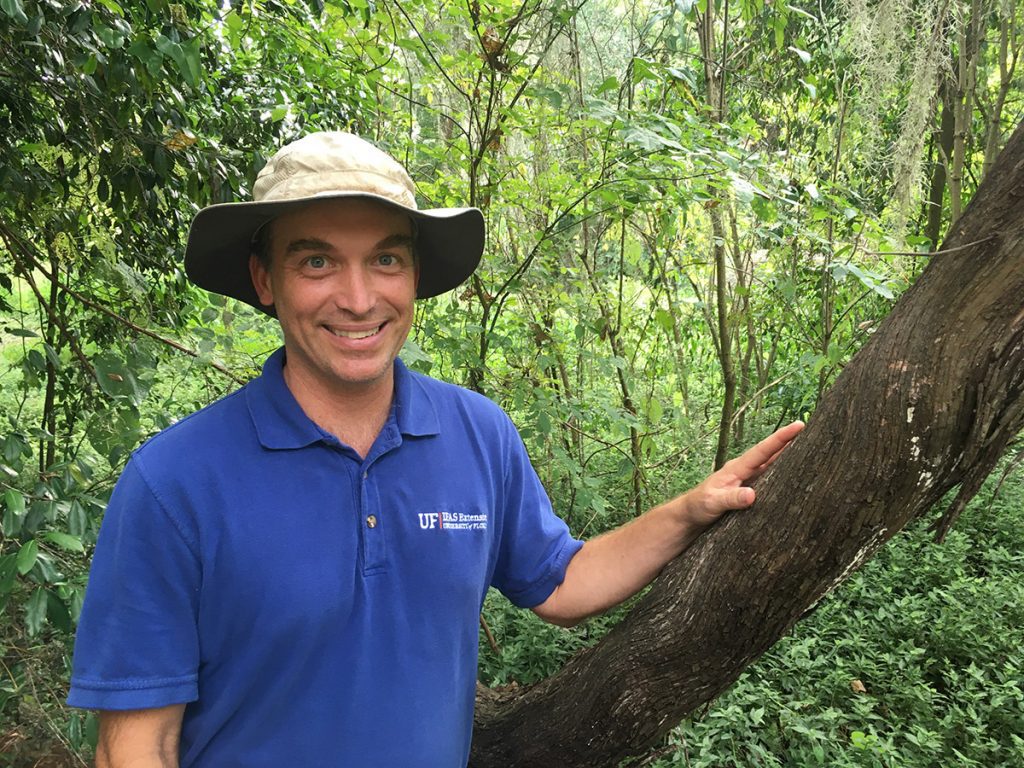
Woody Vines | “…an investment in long-term survival”
Mark, in particular, is focusing on woody vines. These are longer lived, and, once established, more difficult to remove.
“As far as a plant is concerned, you can think of woody tissue as an investment in long-term survival, right?” Mark says. “…an herbaceous plant is like an annual plant that comes up and dies back to the ground. Woody plants put a lot of energy into making wood so that they can persist year to year and continue to get larger and larger, just like this muscadine right here.”
You can see the grape vine next to which Mark is standing; it looks like the trunk of a small tree. In the right place, this is an example of a native species allowed to grow as it would in the wild. But you can see where such a large vine could become a problem in a less ideal setting.
I’ve seen the benefits of letting some vines go in the yard. Nesting Carolina wrens jumping and and extracting insects for their brood, for one. And last year, I discovered that monarchs had been seeking the shelter of vines when building chrysalides.
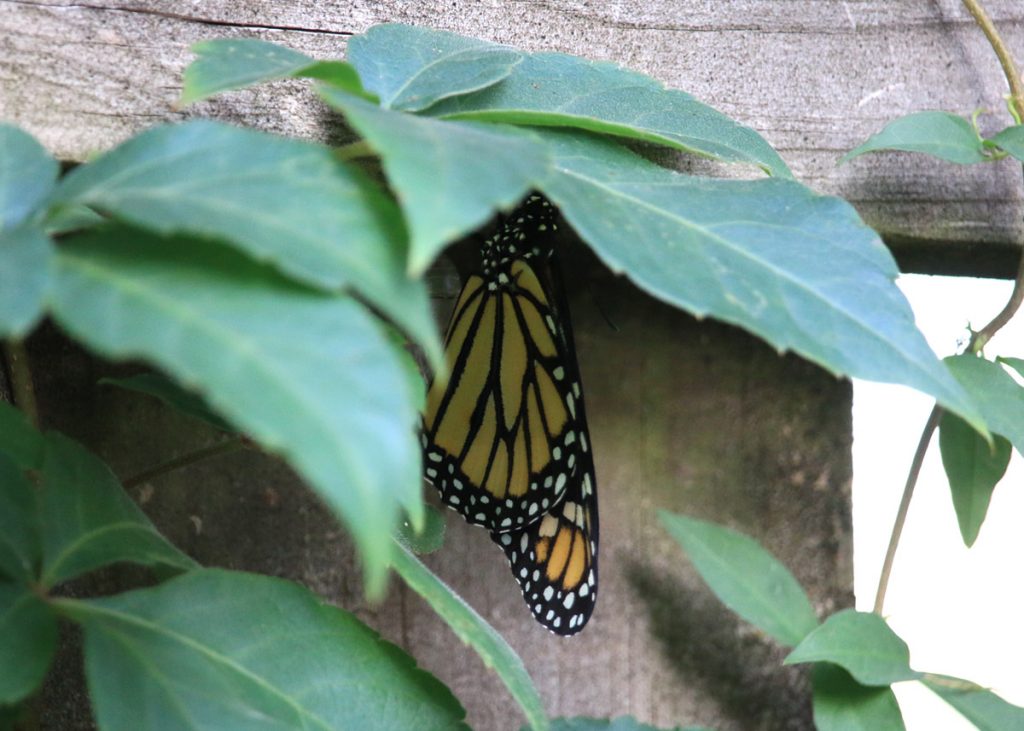
I’ve also spent some time removing vines from the side of the house, and have spent considerable time digging up root systems.
So, should a vine stay or go? Here’s some information on different vines you might find, to help you decide.
1. Grape vines
If you have the space for it, a plant that feeds you is usually welcome. As Mark tells us, Florida is home to six native species of grape vine. They’re in the same genus, Vitis, as the wine grape (Vinis vinifera).
Once I learned what a grape leaf looked like, I noticed how widespread they were in Tallahassee. Muscadine is the prevalent species, but there are others. Mark explains how to tell the difference.
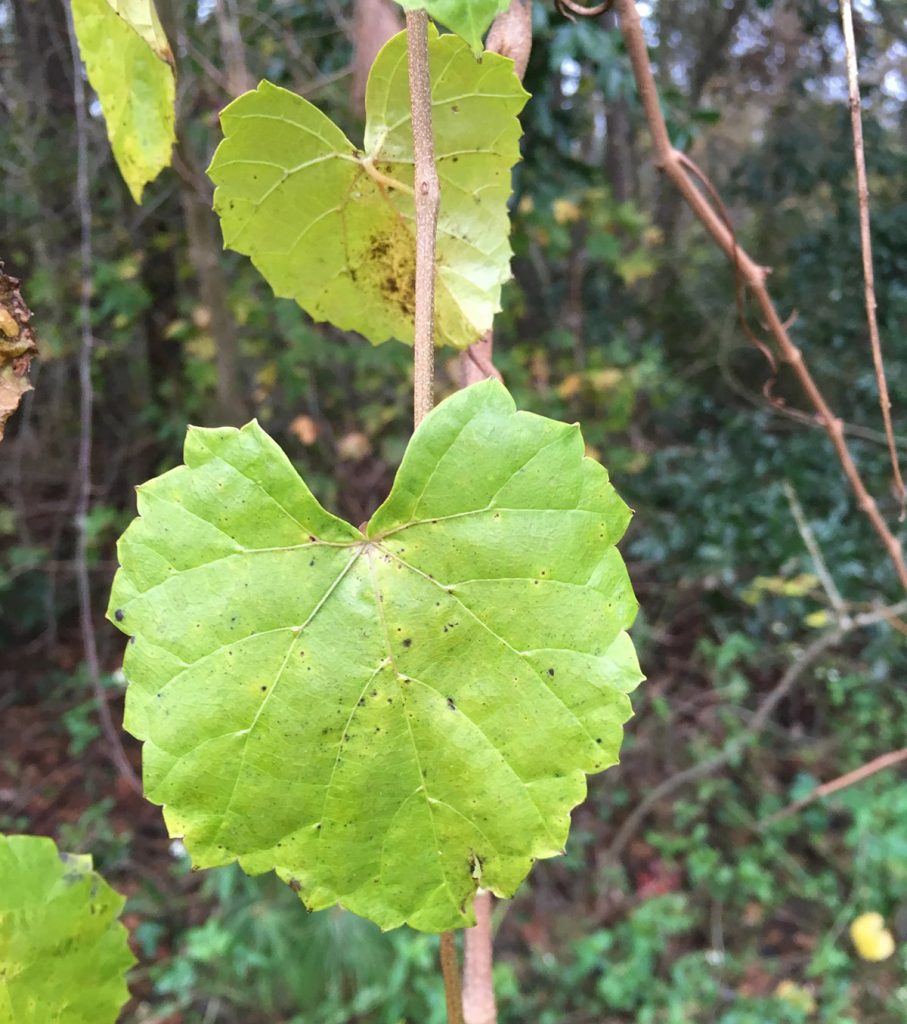
Muscadine grapes (Vitis rotundifolia)
So, we notice how many muscadine grape vines are growing everywhere, and we think- great! So many grapes! But no, sadly.
“…for the most part [grape vines] are Dioecious, meaning that there is a female plant, and there is a male plant.” Mark explains. “And of course, the fruits will develop on the female plant. Unfortunately for us, and for me here in my yard- I’ve got a bunch of grape vine, but they’re all male. So, typically, in the wild, most of the muscadines are male.”
If you have a female vine, lucky you! And if you know where to find them in parks or other public spaces, you may want to keep that to yourself.

Green, unripe muscadine grapes. 
Purple, ripe muscadine grapes.
Muscadine grapes will ripen from late July through September. The ripe fruit will range in color from bronze (known as scuppernongs) to dark purple. Check out this video I produced with former WFSU reporter Kate Payne on picking and eating wild muscadines. With its thick skin, we don’t necessarily want to eat it as we would the European grapes we usually see in the store.
Muscadines aren’t the only native grapes in our area. Grapes all have similar heart shaped leaves; so to distinguish muscadines from the second species Mark found in his yard, he looks at the tendrils used by the plant to attach to trees and other surfaces. Muscadines have a single, simple tendril:
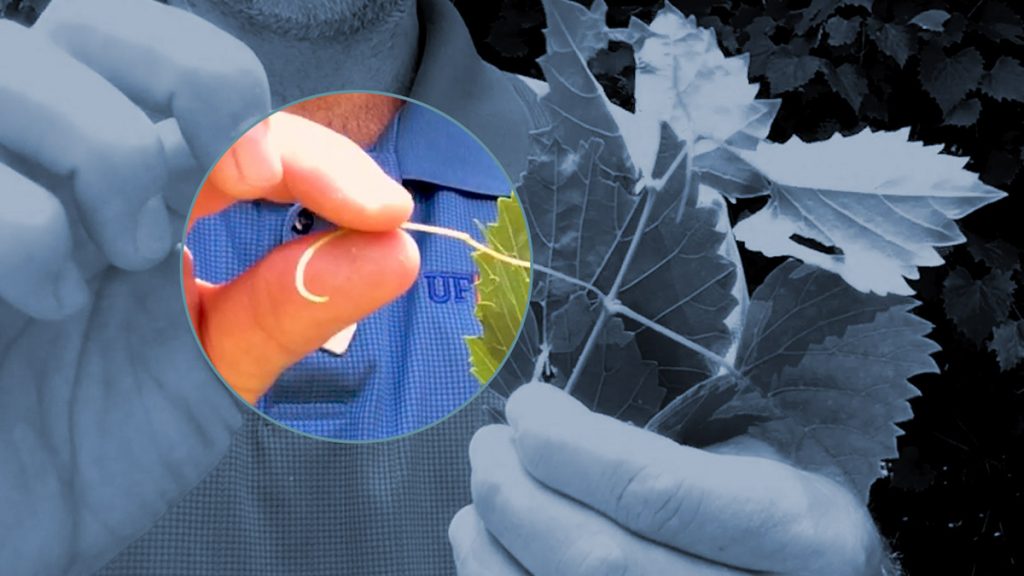
Look for the tendril opposite the petiole, the stalk that connects leaves to the main stem of the plant. “That is a character of all the Vitis, by the way; the tendril comes out opposite of the leaf.”
The Summer Grape (Vitis aestivalis)
Mark walks about 100 feet from his muscadine vine to another native grape species, the summer grape. He shows us two ways to tell the difference between the two species.
One is the tendril. Where the muscadine has that simple, unbranched tendril, “on the summer grape,” Mark says “we have a branched tendril.”
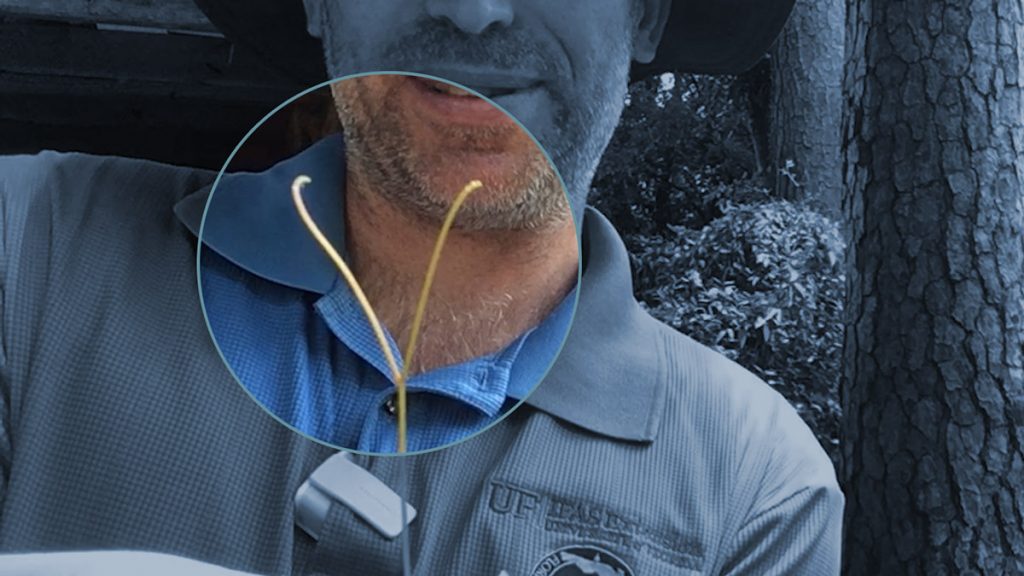
The second way to tell the difference is to feel the underside of the leaf. Summer grape leaves have small hairs underneath.
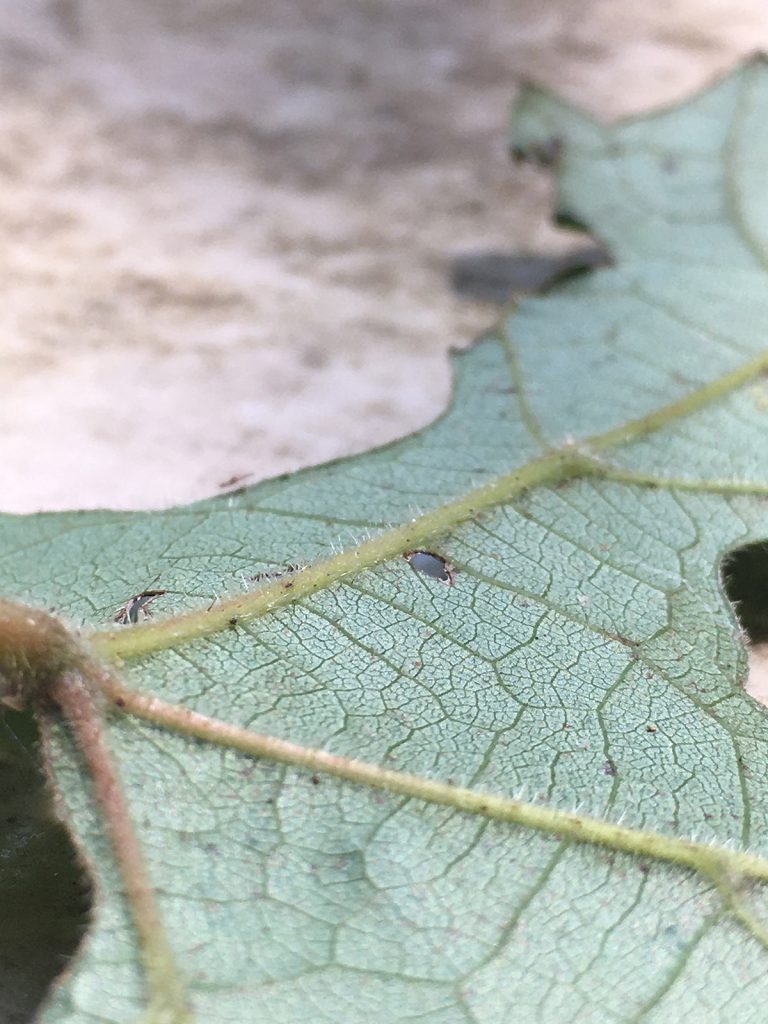
2. Virginia Creeper vs. Poison Ivy
These species are often confused for each other, so we’ll look at them together. It may surprise you that Mark will tell us of the ecological benefits of poison ivy. Maybe you’ll decide that you have a space for it in your yard after all. Maybe.
Virginia Creeper (Parthenocissus quinquefolia)
In 2019, when Tallahassee took part in the City Nature Challenge, Virginia Creeper was the second most identified species (behind Spanish needles- Bidens pilosa). It’s pretty much everywhere. Muscadine grapes checked in at fourth.
It has a little bit of a resemblance to poison ivy, which is also common. And it’s not uncommon to see the two growing side by side.
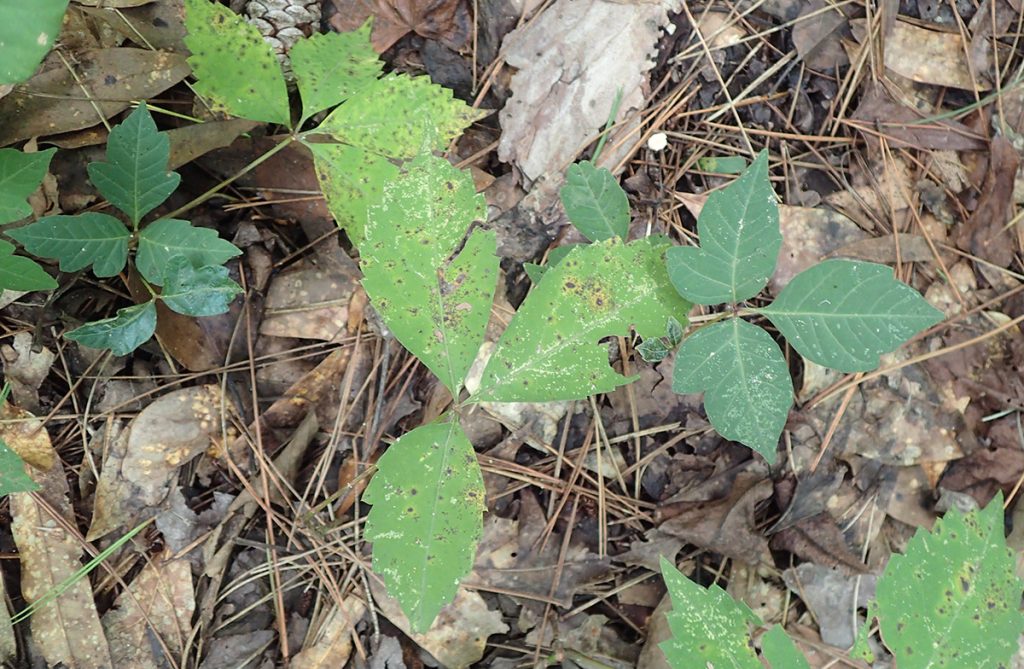
You’ll notice the creeper has serrated leaves, much like grape leaves. “This is actually in the grape family.” Mark says. “So the genus grape is Vitis. The grape family is the vitaceae; Parthenocisis is one of the genera within that family.”
In the photo above, you’ll see the Virginia creeper has clusters of three and four leaves, and they commonly have five leaves as well.
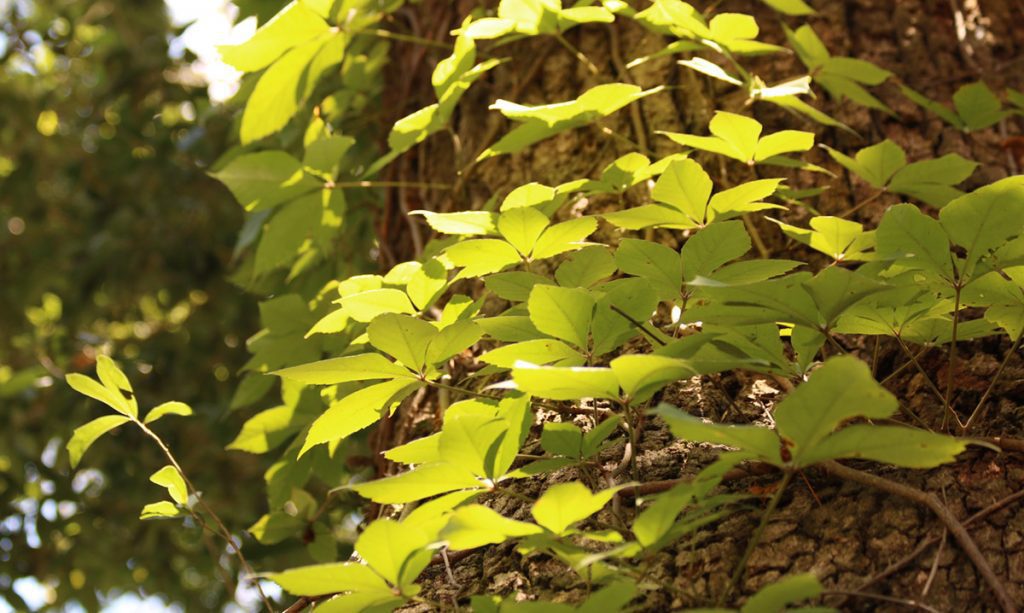
Unlike grape vines, Virginia creeper does not use tendrils to attach to the surfaces on which it grows. Instead, it uses an organ called a hold-fast. Once the vine latches on, it can be damaging to remove from painted or finished surfaces. So you’ll want to manage accordingly, if it’s growing where it can attach to such a surface.
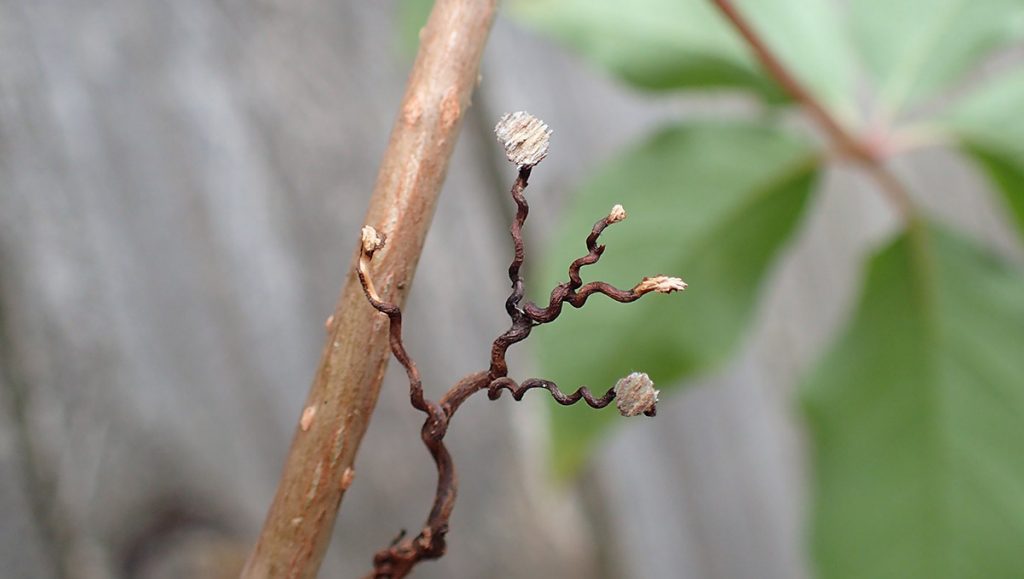
It is weedy, and it does grow everywhere. But if you have a space for it, insects eat the leaves (including several species of sphinx moth). Its berries are toxic to humans, but feed birds through the winter months.
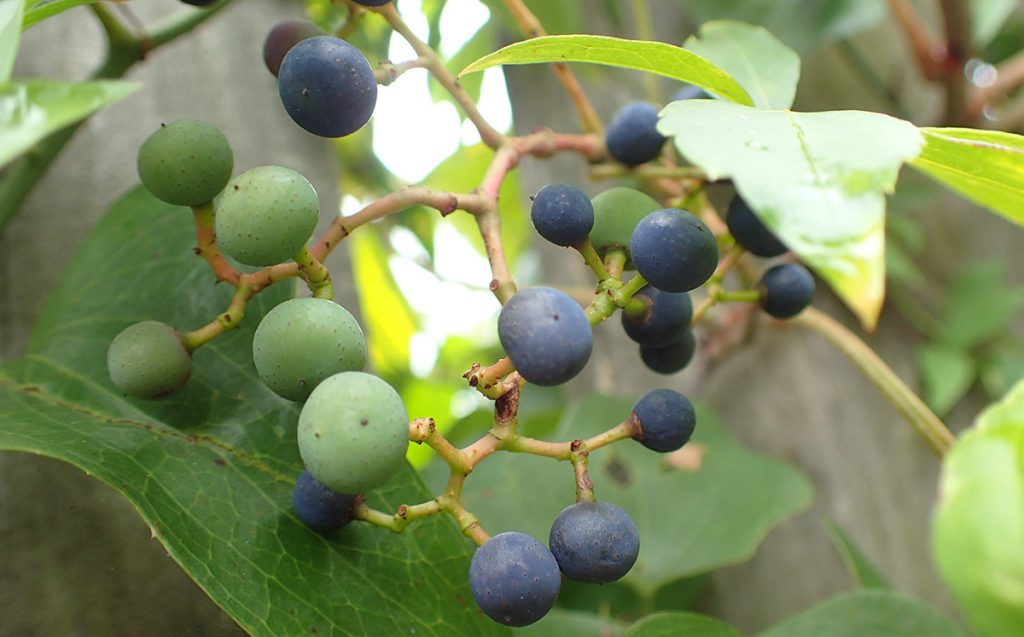
Poison Ivy (Toxicodendron radicans)
I myself have had a couple of harsh poison ivy rashes, and many of us are allergic to some degree. So this plant isn’t for everyone. And yet, even it has an ecological value.
“So poison ivy, again, will always have those leaves of three,” Mark says, “where Virginia creeper will often have leaves of four or five. The other thing with poison ivy is they always have… that reddish tint to the petioles- that’s the base of the leaf.”
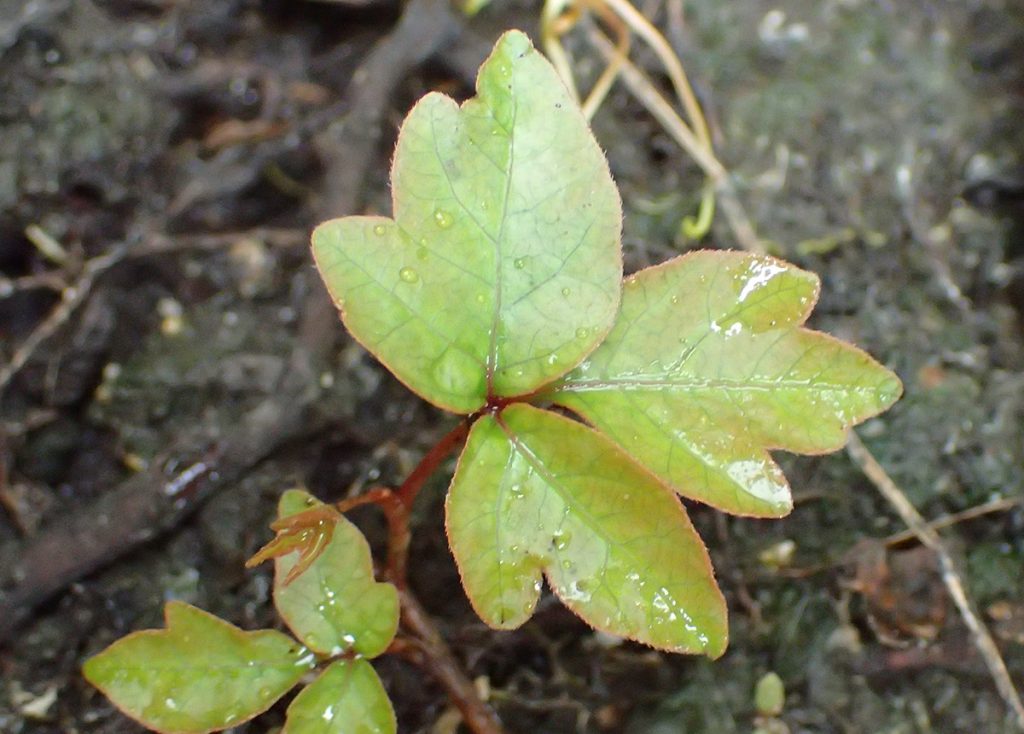
“The important thing to remember is that poison ivy is a very important food plant for birds, mammals, all sorts of wildlife.” Mark says. “Humans, kind of interestingly, are the only mammals that… show a reaction to poison ivy.”
This plant does grow aggressively, and some of us are more allergic to it than others. If you have a large enough yard, and it’s growing in a space you don’t use, you might consider letting it grow.
“But where this plant is growing in an area that you walk through often, or if you’re very sensitive- like my daughter who’s very sensitive to poison ivy- really the best way to control this is some herbicides.”
If you need to remove it, Mark recommends Triclopyr, a chemical compound used as an herbicide and fungicide.
3. Smilax | Greenbrier, or Catbrier, Family
Here’s another type of vine we see everywhere. We see thorny Smilax vines in our yards, parks, and out in the forest as well. “There’s about 12 species of native smilax to Florida.” Mark says. “We can have about… five or six, maybe a couple more around here in north Florida.”
While Smilax species share certain traits between them, like thorny stems and edible growing tips, they have many characteristics that differentiate them as well. We’ll look at leaf shape and the thorniness of the stems.
These vines do have their ecological benefits, but they are aggressive growers, and you may not want to deal with their thorns in certain places. Once established, digging them up can be labor intensive. “So if you found these in your garden, your yard, and you’ve cut them back, you’ve noticed that they just pop right back up.” Mark says. “Well they have huge root systems, almost like big storage organs, these big tuberous root systems.”‘
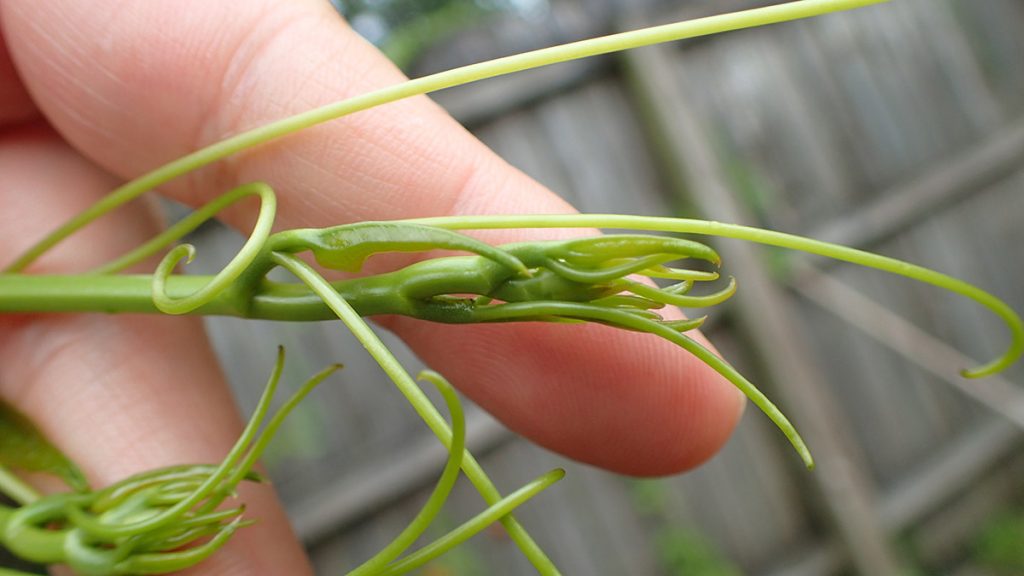
The growing tips are a food source for animals, and for hikers and gardeners who come upon them. Especially in the springtime, Mark says, “they’re very tender, and they have a little bit of an asparagus flavor.”
Saw Greenbrier (Smilax bona-nox)
Smilax bona-nox has a fiddle shaped leaf:

Saw greenbrier leaf. 
New saw greenbrier leaf.
You can see its tendrils in the second leaf photo above, and in the photo of its growing tip above that.
Here is its stem:
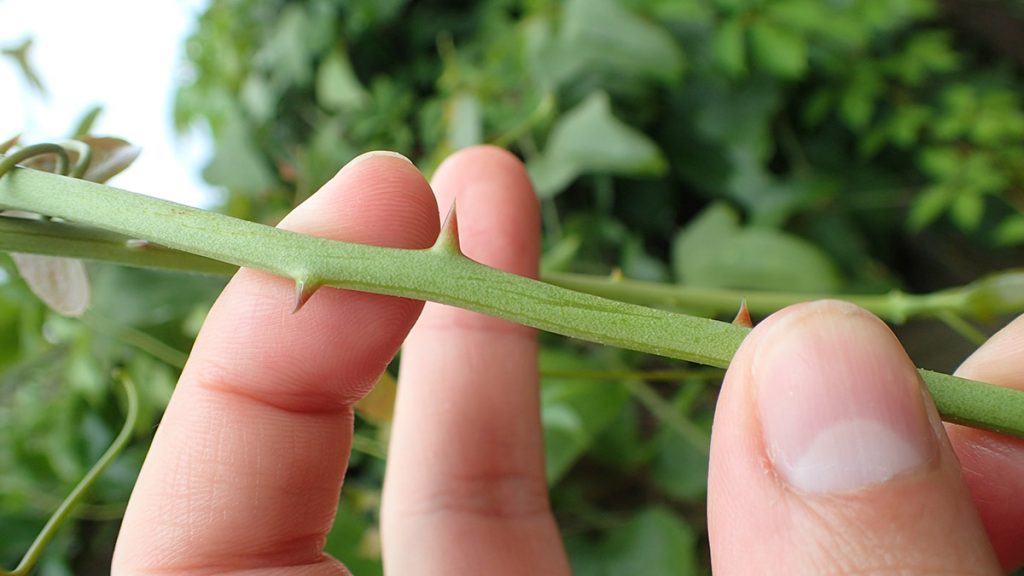
This is the species I most identify with the Smilax genus, with the fiddle shaped leaves that make it so easily identifiable.
Bristly Greenbrier (Smilax tamnoides)
Smilax tamnoides has leaf shape that varies from fiddle shaped to something a little more ovalesque.
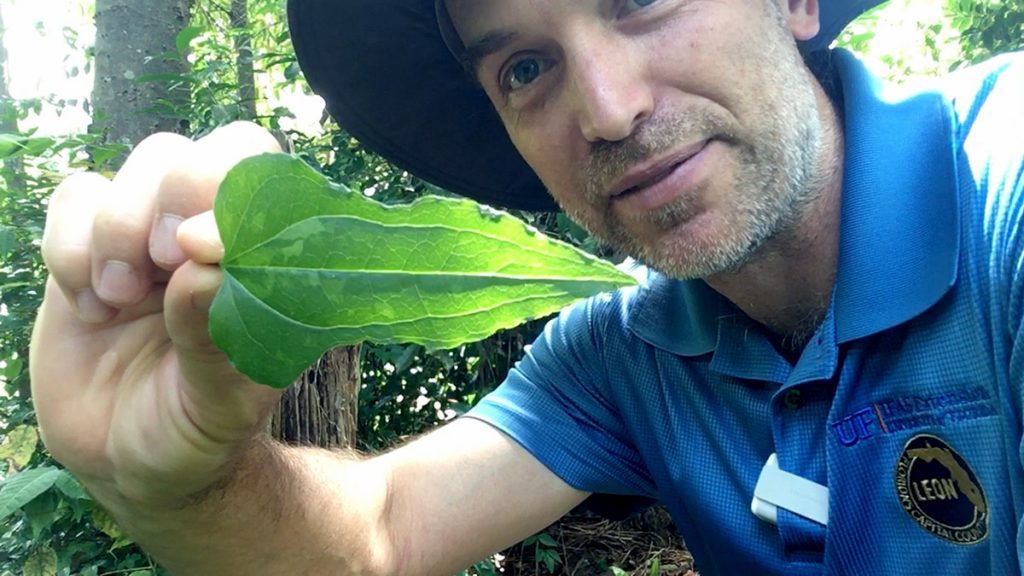
The easiest identifying characteristic of this species is its stem, which gives it its name:
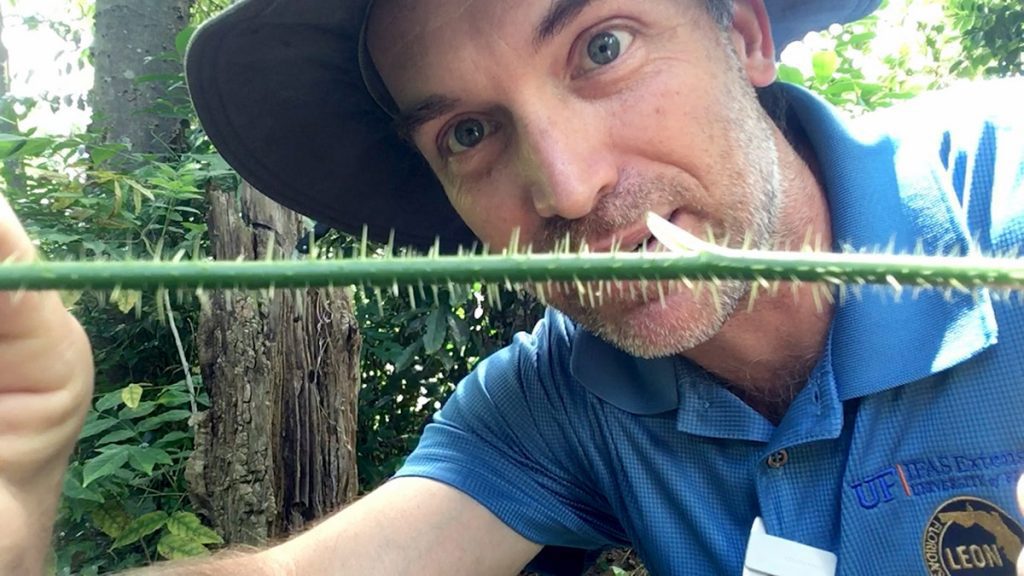
“Look at the thorns.” Mark says. “These are still kind of soft, so it’s not hurting me too bad right now. But look at the thorns on that.”
Laurel Greenbrier (Smilax laurifolia)
“You can see this one here, same thing: tendrils, but this one does not have that kind of fiddle shape leaf to it. This is Smilax laurifolia, yet another one of these Smilax species that you could have in your own backyard.”
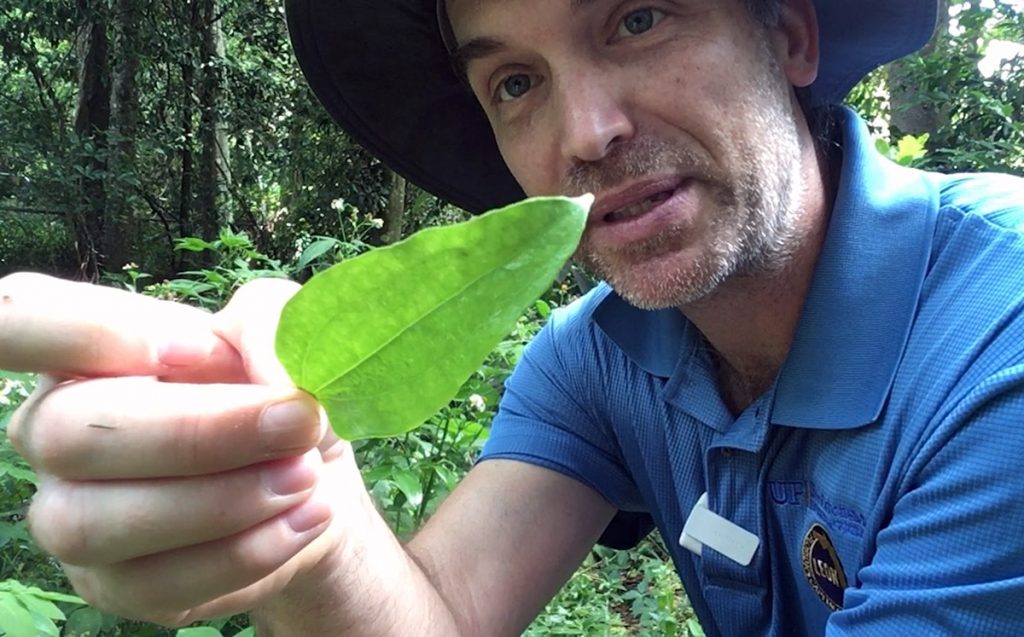
Cat Greenbrier (Smilax glauca)
Smilax glauca gets its name from its glaucous underside. But what does glaucous mean?

The whitish underside of a Smilax glauca leaf. 
The underside of a Smilax laurifolia leaf.
Notice the glaucous, whitish underside of Smilax glauca compared to the laurel greenbrier.
Sarsparilla Vine/ Dwarf Greenbrier (Smilax pumila)
I’m going to include a couple of species Mark didn’t shoot for his video. I noticed them when searching for Smilax in my iNaturalist observations, and some are quickly taken phone photos. I apologize for the lesser quality photos, but I wanted to include a couple more species if I could. I’ll make sure to take replacement photos when I next encounter these species.
I wanted to include Smilax pumila because of its neat little red fruit:
As you can see, it has somewhat rounded fiddle shaped leaves. As you can judge by its name, this is small vine, which grows along the ground. It’s also relatively thornless.
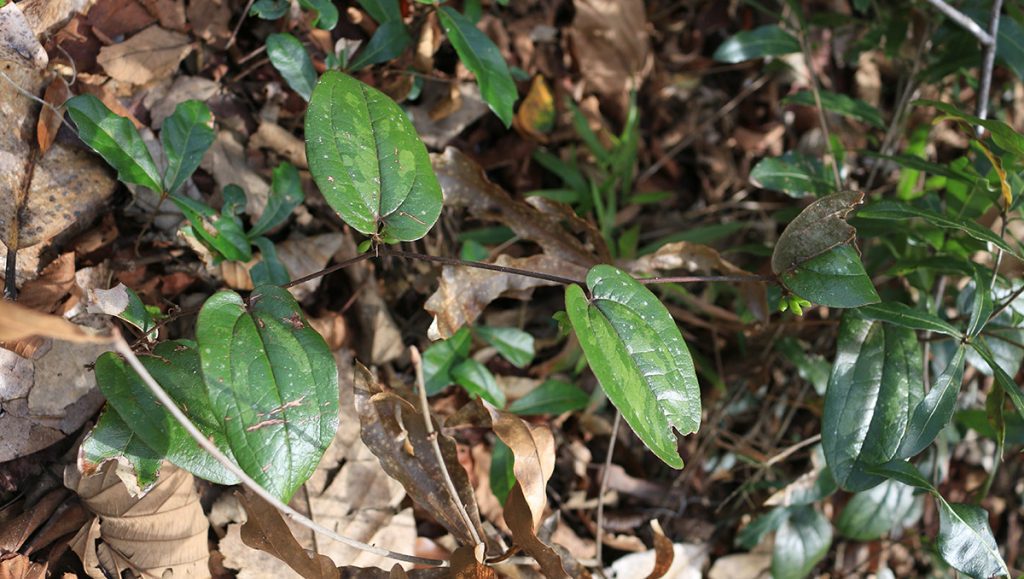
Earleaf Greenbrier (Smilax auriculata)
Here’s one I must have photographed because it was flowering.
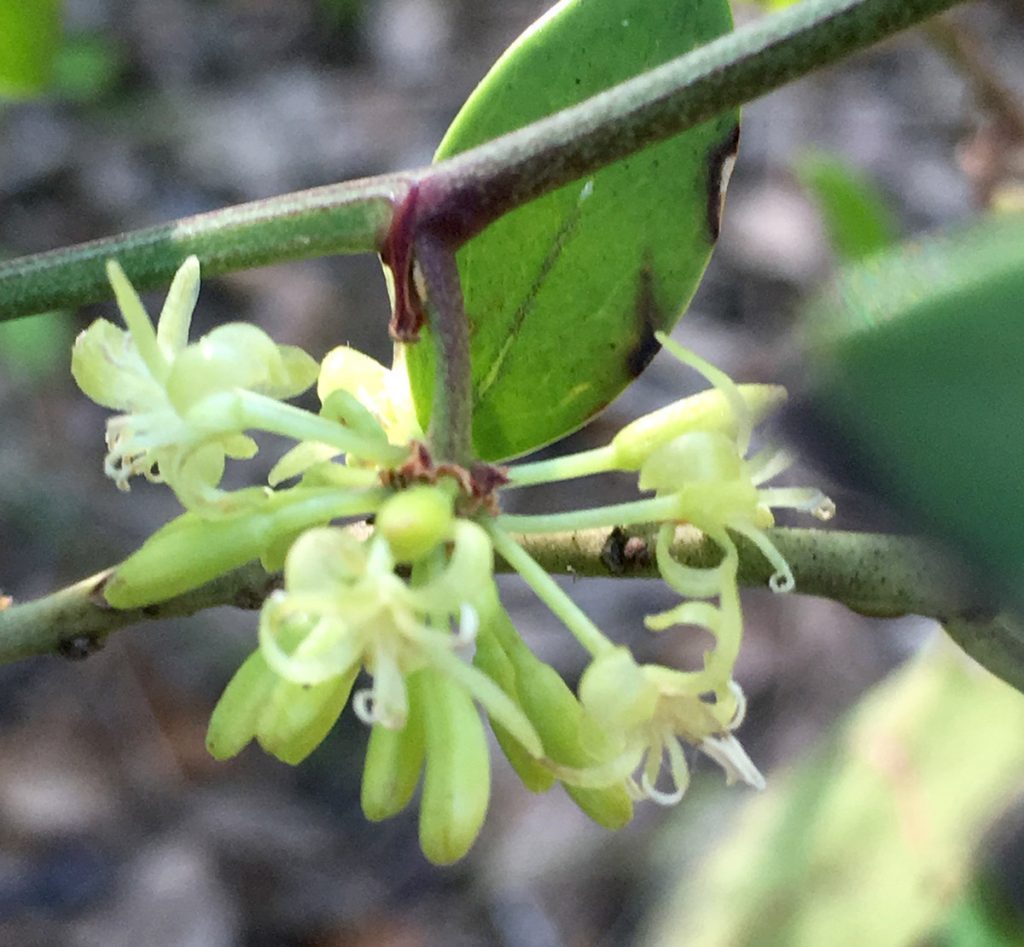
The leaves are elongated fiddle shaped:
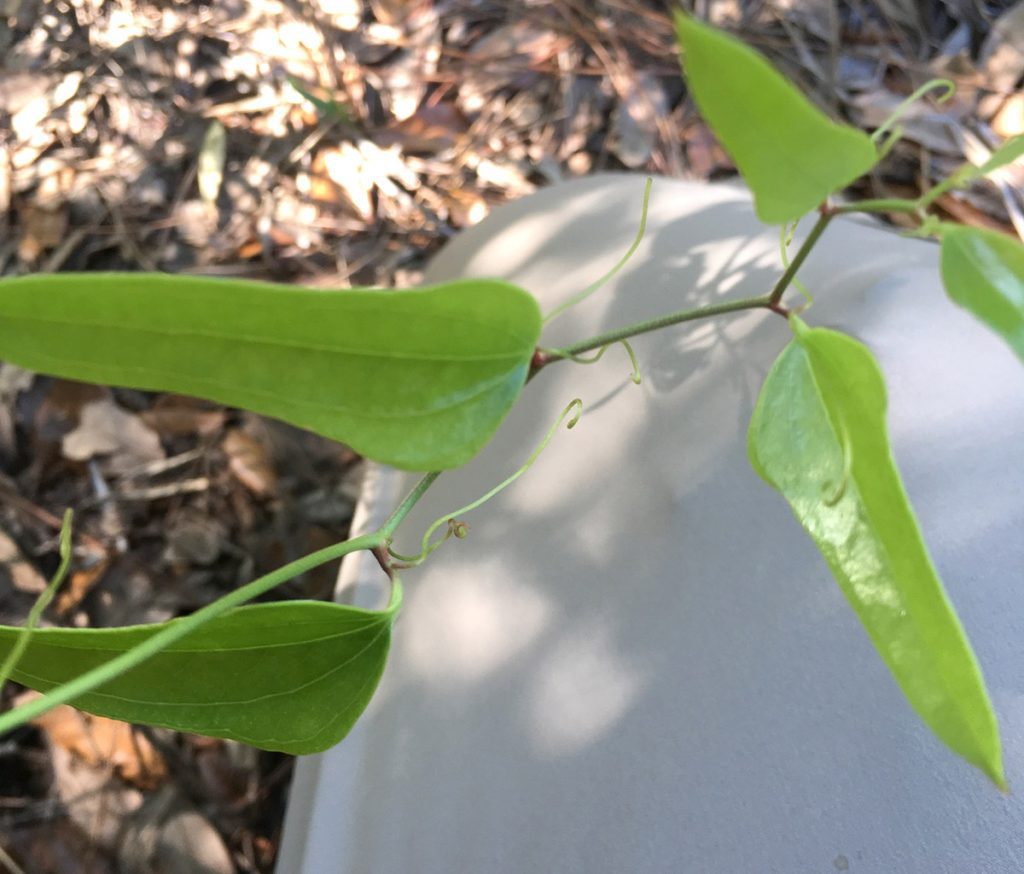
4. Woody Vines with Showy Flowers
All of the vines above flower, and make fruit. In the next two sections, we’ll look at vines we might find attractive because of their larger, more colorful flowers. This section deals with a couple of natives, but in the next, we’ll look at vines that are pretty, but invasive.
Trumpet Creeper (Campsis radicans)
Here’s one I notice blooming in the summer months, on fences and trees. It has these reddish orange flowers which are popular with hummingbirds.
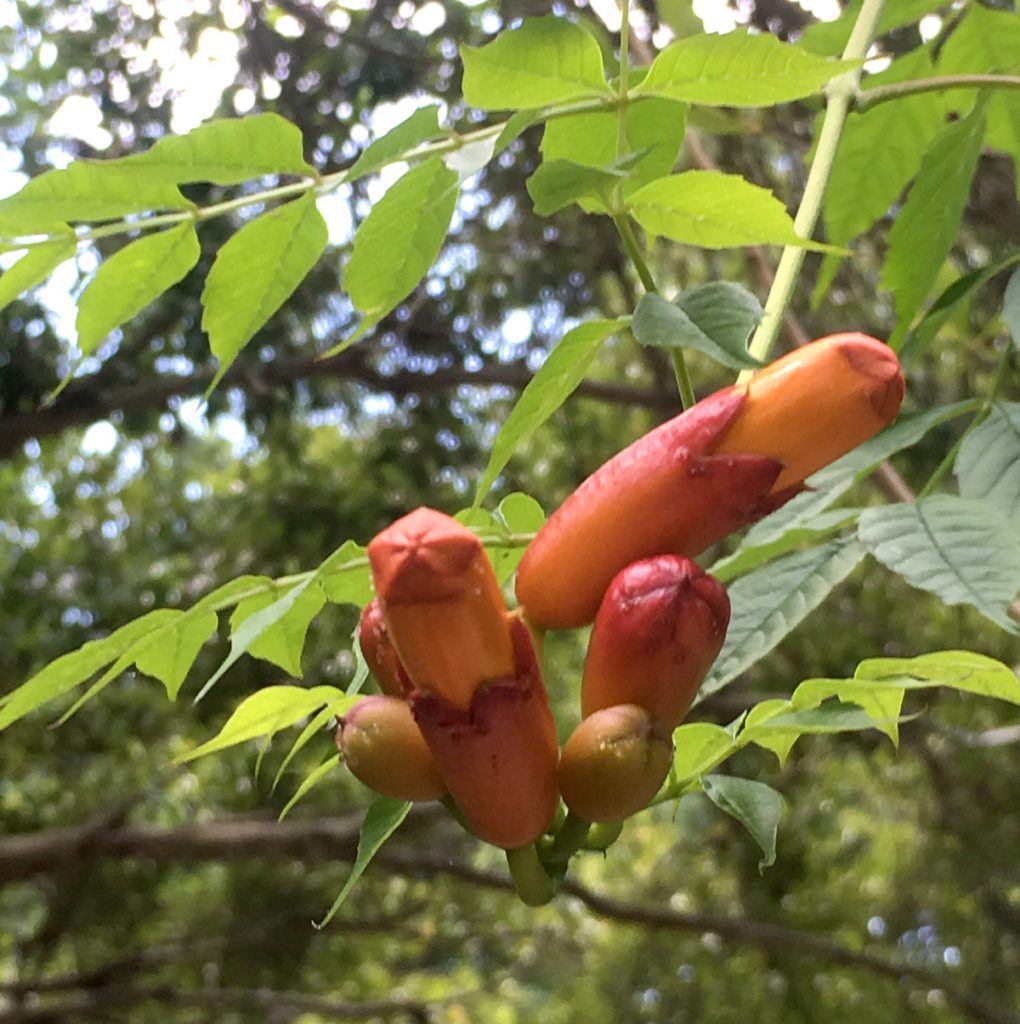
Now, if you see this vine in the months in which it does not bloom, how will you know what it is? You can see its leaves in the photo above. “Trumpet creeper is in the Bignoniaceae family, which is known for its characteristic opposite leaves.” Mark says. He holds up a section of the vine for a closer look:
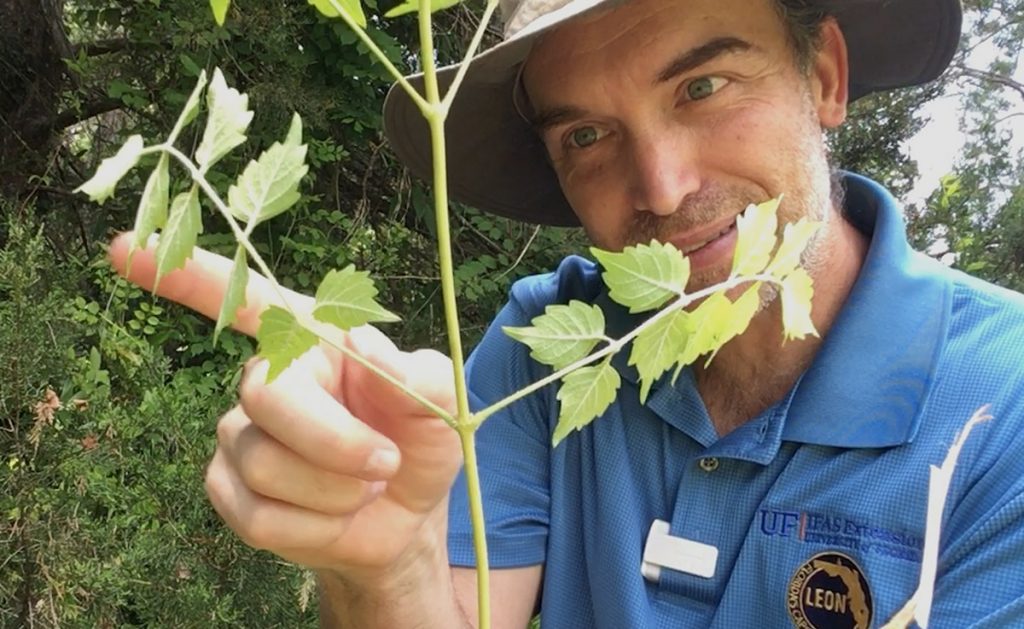
“Let me show these opposite leaves- opposite compound leaves- right? Opposite compound. So that’s Bignoniaceae family.” While he’s holding that section of vine, he points out the aerial rootlets the plant uses to attach to surfaces.
He finds a trumpet creeper seed pod. “So here is the fruit of trumpet creeper. It almost looks like a vanilla bean or something.”
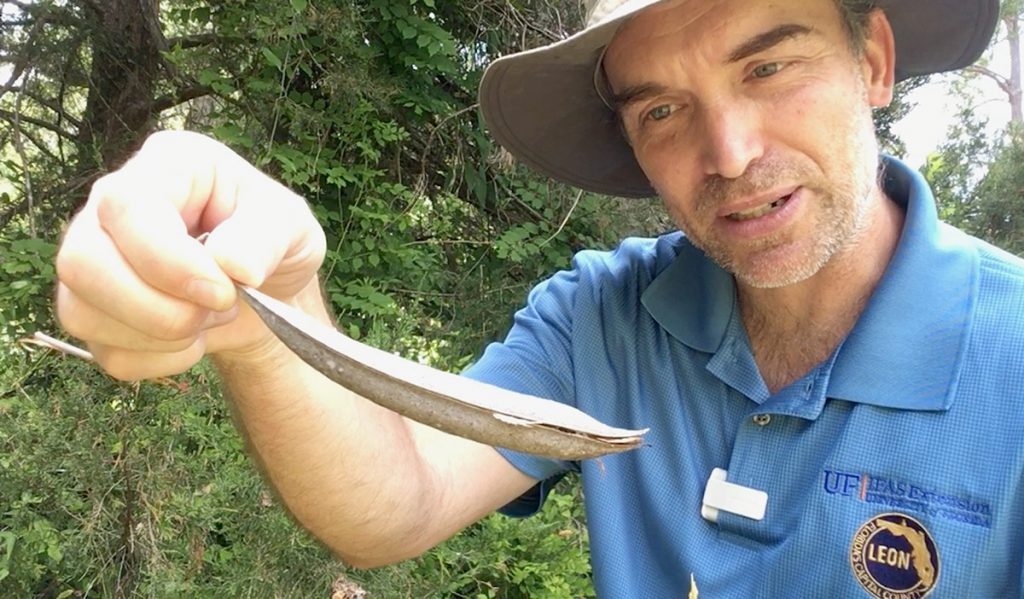
He breaks it open, revealing its winged seeds. “See, there’s a seed in the middle and that all that fleshy stuff around it is the wing.” When the fruit cracks open, or an animals breaks it open, the seeds will fly out. The wings will catch wind and disperse the seeds.
Yellow jessamine (Gelsemium sempervirens)
Here’s a vine I don’t often notice until I see its flowers on the ground. Yellow (or Carolina) jessamine is one of our first spring blooming flowers. After this year’s mild winter, I saw it in late January and early February, where in other years I’d seen it in late February and March. Anyhow, I’d be walking through the stand of trees next to WFSU, and I’d notice these little yellow flowers on the ground, look up, and see the vine high up in a tree.
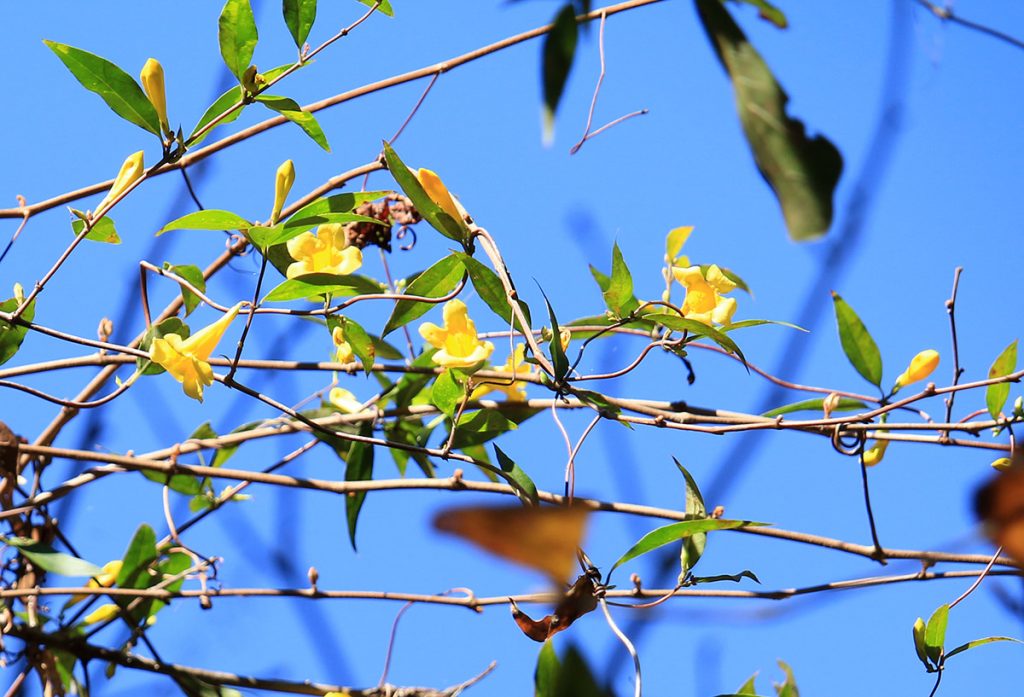
“Here’s a woody vine that doesn’t use tendrils to grab and climb up trees and shrubbery.” Mark says. “It just uses its viney nature, right? So you can see it just kind of winds and winds and winds.”
While many of us appreciate a little bit of color when the world is still kind of grey, these pretty little flowers can be a concern for one beneficial insect.
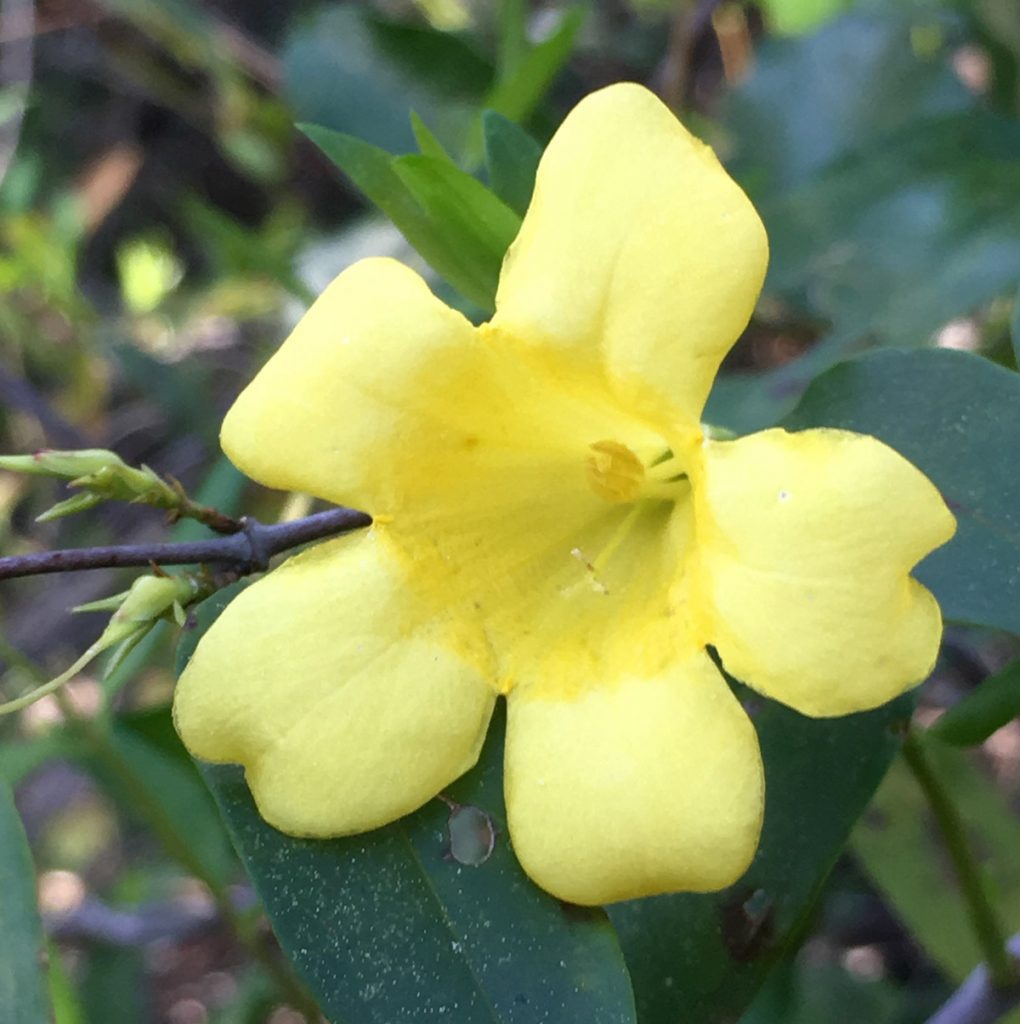
“This is a native species.” Mark says. “There is some issue with the flowers being somewhat toxic to honeybees, so that’s one issue [for] honeybee producers, or apiarists.”
Honeybees are not native, but are an important agricultural animal. Native bumblebee and carpenter bees, as well as tiger swallowtails, do take nectar from yellow jessamine. I found this article on wildflower.org that goes into some more detail on the plant’s toxicity to bees, and the available research.
5. Woody Vines with Pretty Flowers- The Invasives
Mark shot video of one invasive vine in his yard. I’m going to include a second that I found in my yard earlier this year. And I’m going to start with that one because we were just talking about yellow jessamine; and at first, I thought that might be what I had.
Catclaw vine (Dolichandra unguis-cati)
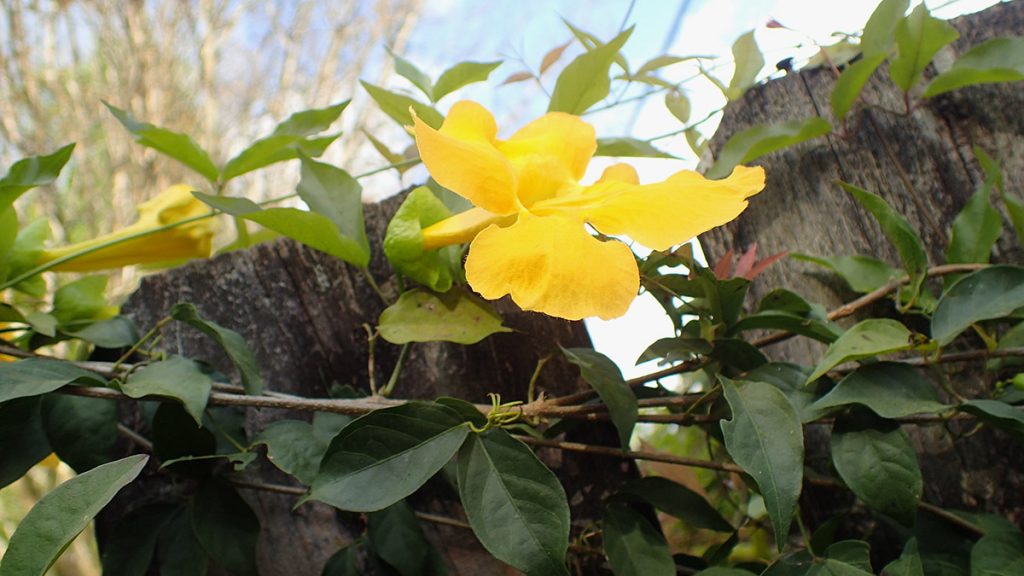
This is a Bignonia, like the trumpet creeper; and like that vine, it attaches with aerial rootlets.
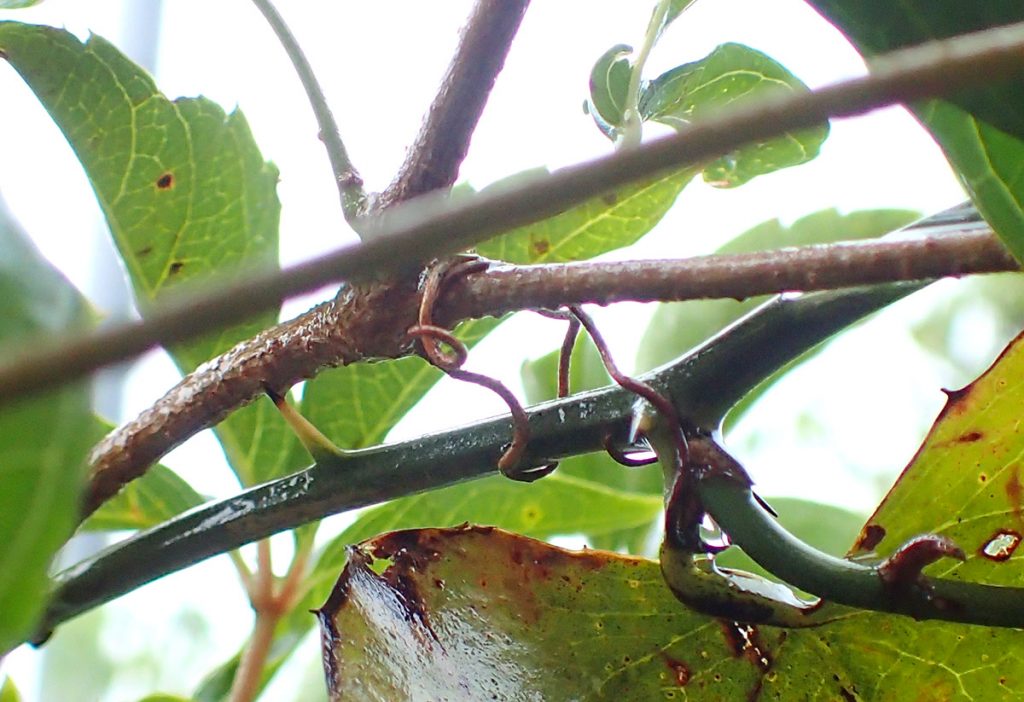
We see three vines in this photo; the woody vine running through the center is catclaw. You can see its rootlets grabbing onto a Smilax vine, which is the green, thorny vine. The way it’s entwined with both a Smilax bona-nox and Virginia creeper makes it trickier to remove, especially with the rootlets attaching it to the other vines.
Anyhow, I’ve seen it flowering both in early spring, and again as I started working on this post in late July. From a distance, it does look like jessamine, but catclaw blooms at different times than you’d see jessamine. Catclaw is an exotic invasive, native to Central and South America, and the Caribbean.
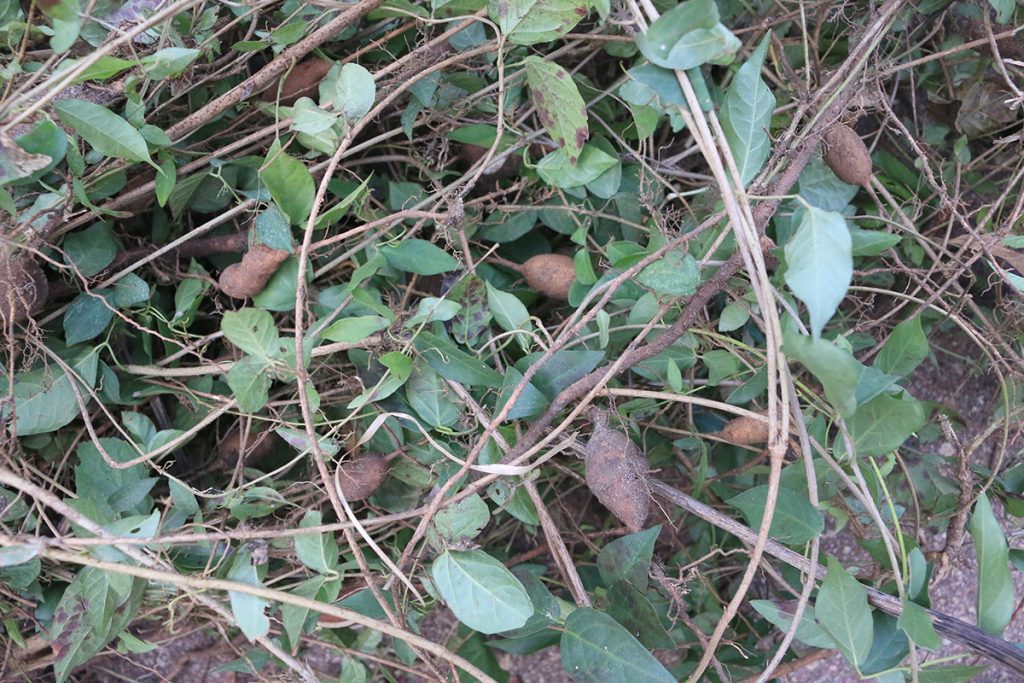
This is a particularly insidious vine. It runs across the ground as well as up trees and fences. It can be easy to miss its leaves in grass. When you go to dig it up, you’ll notice that the vine is rooted every few inches by a tuber. So, unlike other vines that have just that tuber where it originates, this one creates new tubers all over your yard. Even if you’re meticulous in pulling them up, it’s easy to miss a tuber here or there, from which sprout new vines. What was once one vine may become multiple new ones.
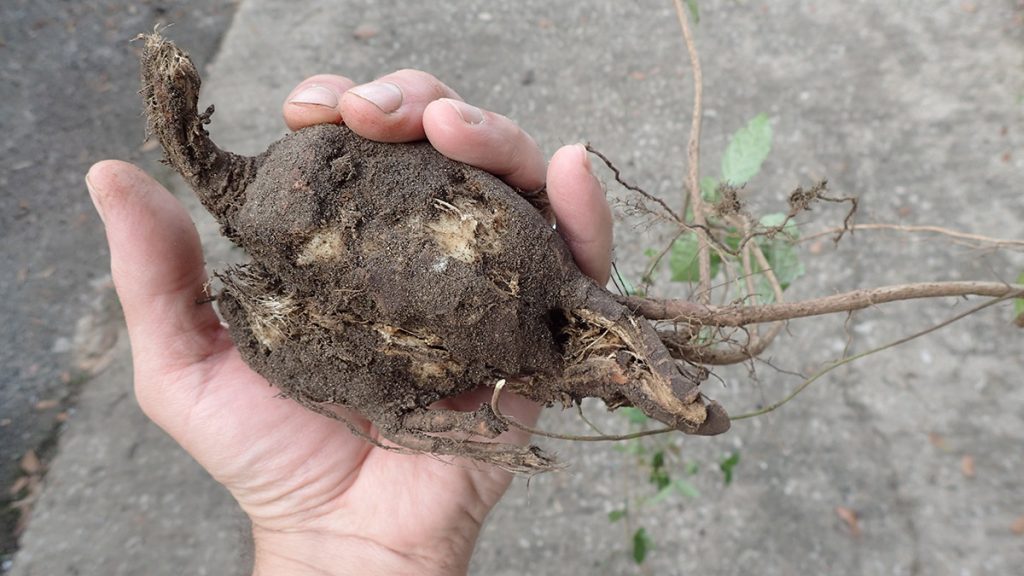
When you do trace the vine back to its source, you may find a large tuber like this one. I find these up against fence posts and tree roots, where they can be hard to remove. This plant is a survivor, using multiple strategies that help it thrive and spread.
Chinese wisteria (Wisteria sinensis)
Here’s a very showy, attractive plant. It’s not native, but people plant it because of its purple hanging flowers. Unfortunately, it spreads and becomes invasive.
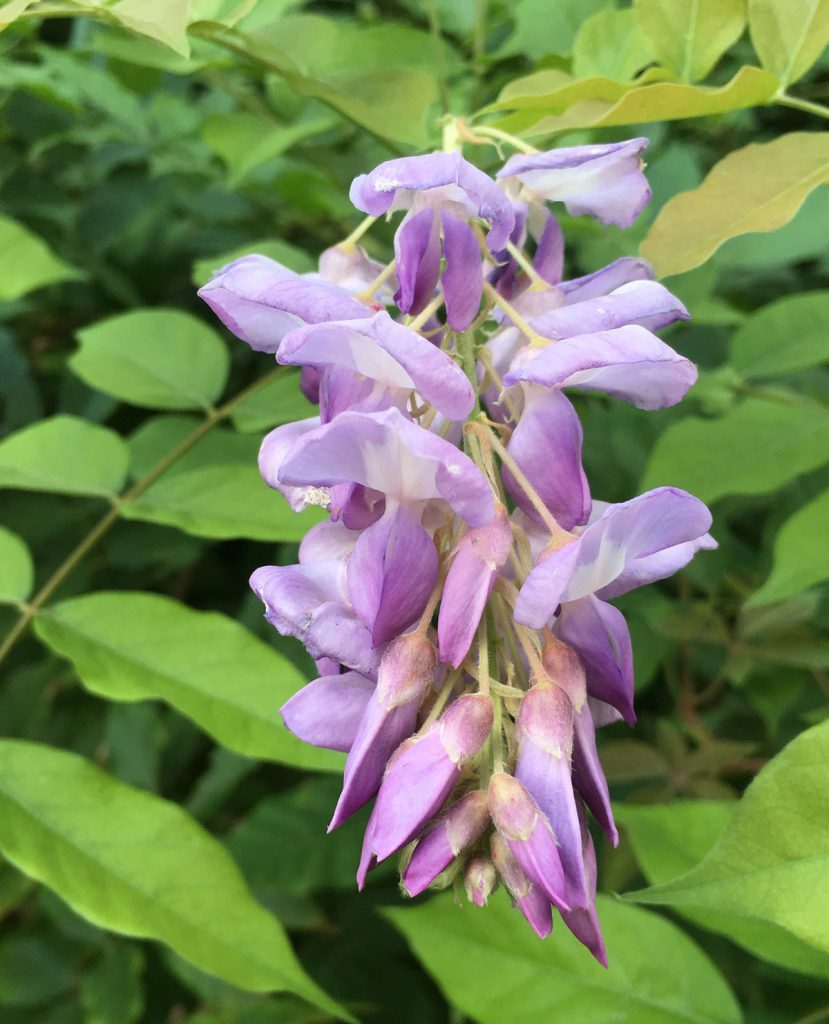
“Compound leaves- so, multiple leaflets on one leaf,” Mark says. “This is in the legume family and they have these very wide bases to their petiole. See those right there? They’re very swollen. A lot of times bean plants will have that on there.”
Here is a look at the leaves:
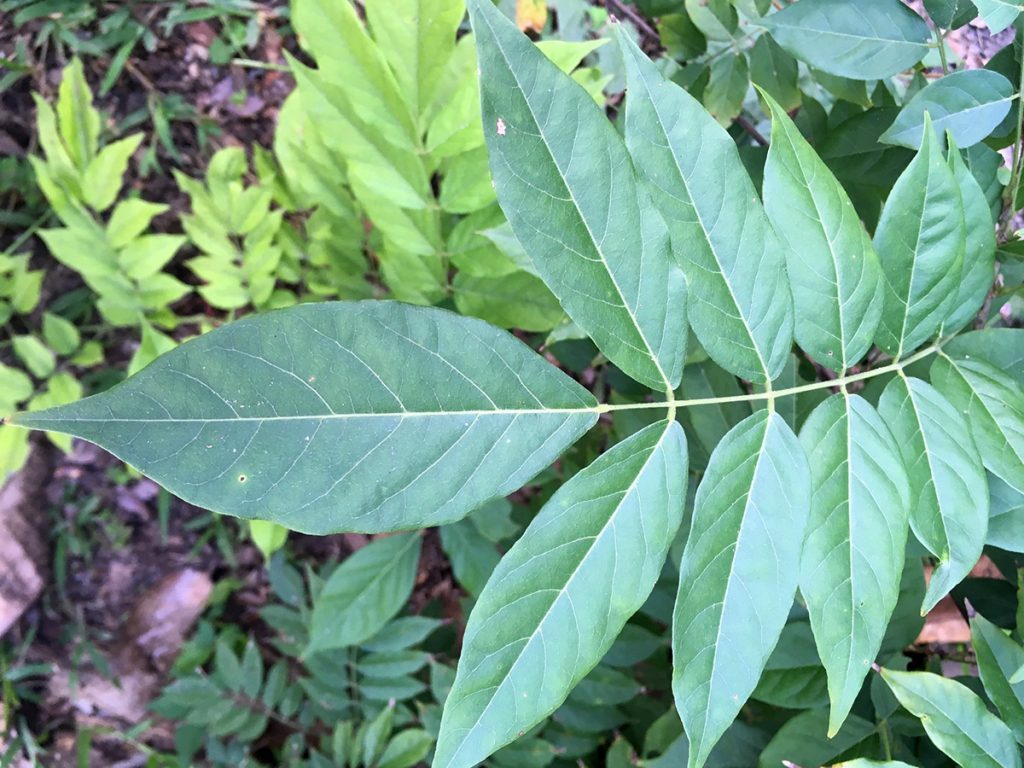
“If you have it in your yard like I do, you also know it’s very hard to get rid of,” Mark says. “I’ve been working on this little patch for quite a while just by hand pulling. I haven’t hit it too hard with herbicides yet.”
I came upon this plant one time at Chapman Pond in Myers Park. You can see how it covered a shrub here:
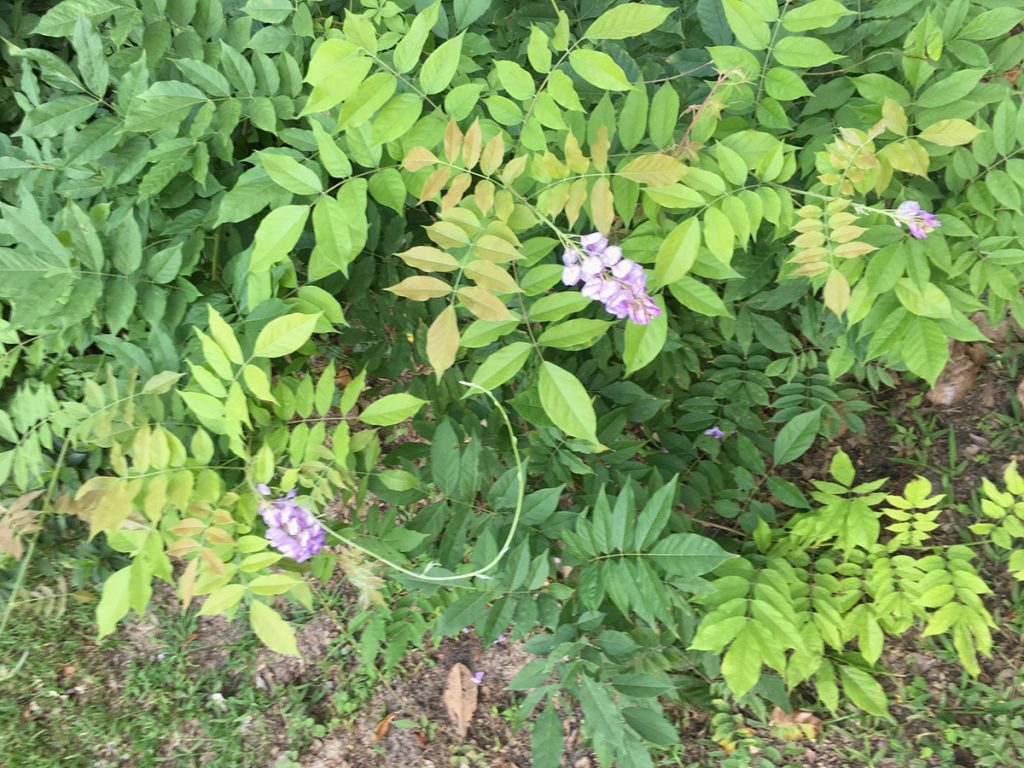
It is pretty, isn’t it? It’s no wonder people like to plant it. But Mark has an alternative.
“The important thing to remember with Chinese wisteria is that there is a native wisteria that looks just as beautiful. And if you are considering planting something like wisteria, you know, please plant the native. And if you have the invasive wisteria, and you just don’t want to get rid of it because it looks so pretty, just know that you can remove it and replace it with the native species.”
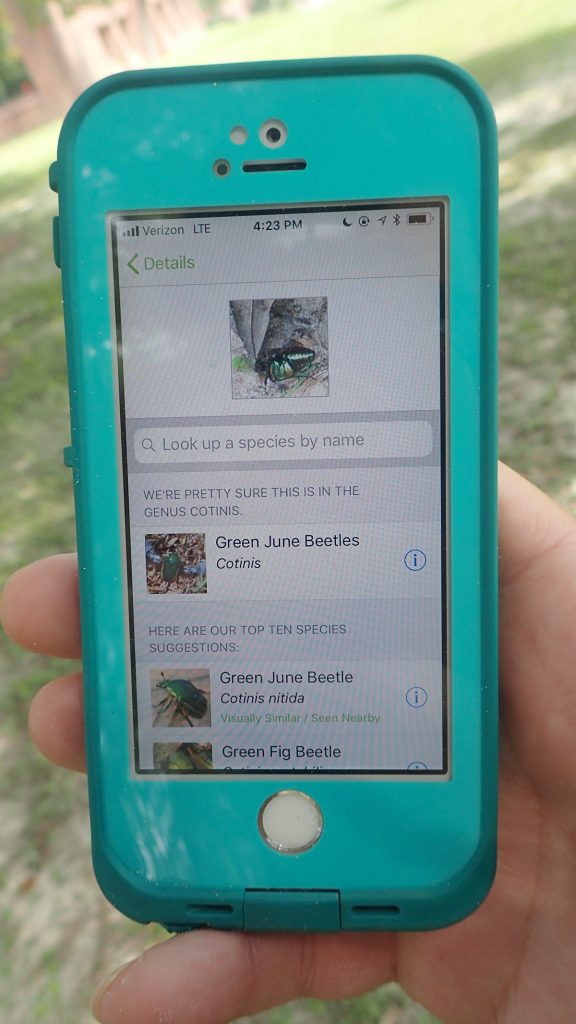
Apps and Citizen Science mentioned in the Backyard Blog
iNaturalist
Identify plants, animals, lichens, and fungi in your yard. Other users correct your identifications if you’re wrong, and even if they don’t, it can be a good springboard to further research.
Seek by iNaturalist
Instant identification, and it doesn’t record your location. This is a good option for kids with phones.
Monarch Larva Monitoring Project
Enter information about monarch caterpillars in your yard, and help researchers get a sense of the health of the monarch population that year, and how and when they’re migrating.
Great Sunflower Project
Record the number of pollinators visiting your flowers, and help researchers map pollinator activity across the country.
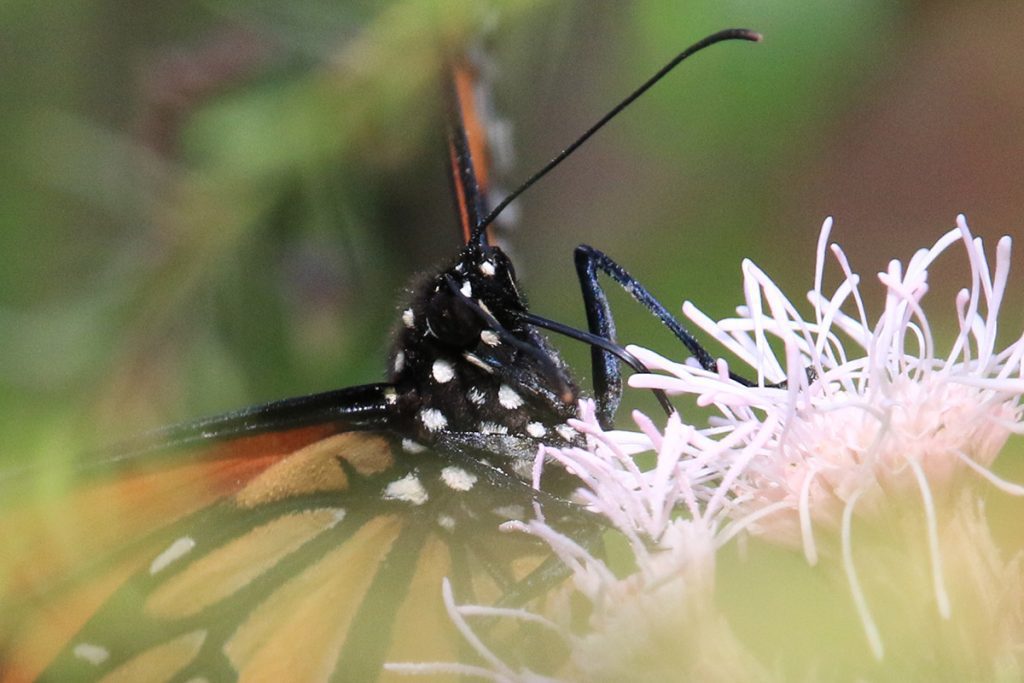
Dig Deeper into Backyard Ecology
What can we do to invite butterflies, birds, and other wildlife into our yards? And what about the flora and fauna that makes its way into our yards; the weeds, insects, and other critters that create the home ecosystem? WFSU Ecology Blog takes a closer look.

